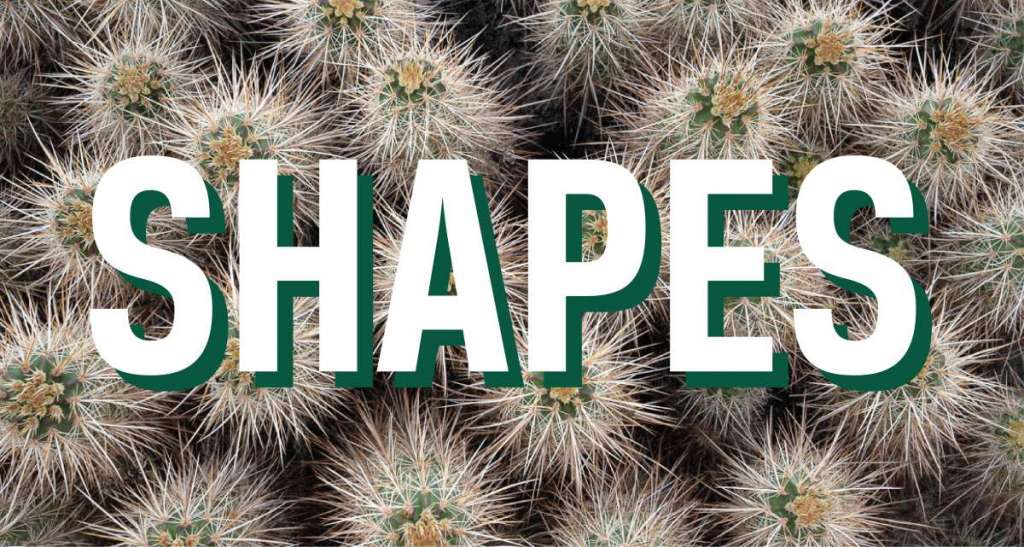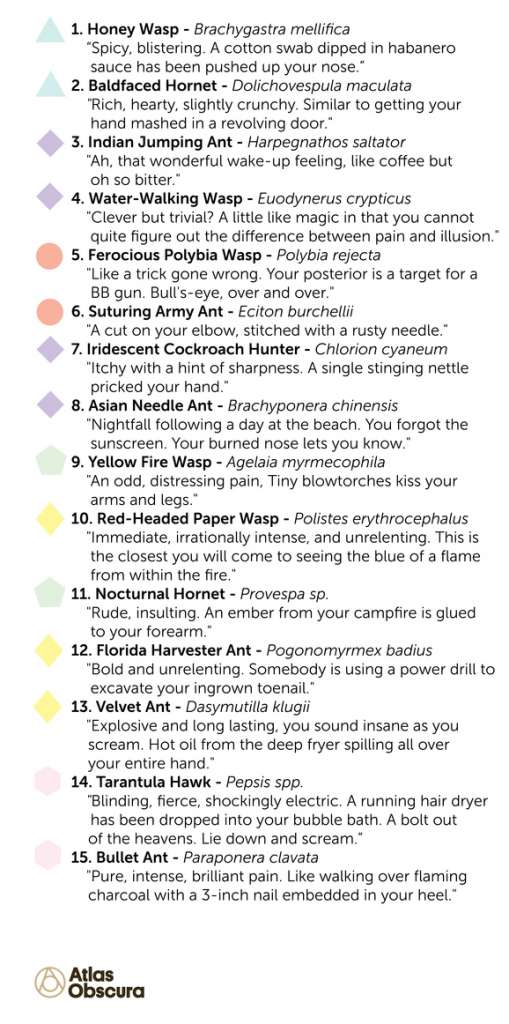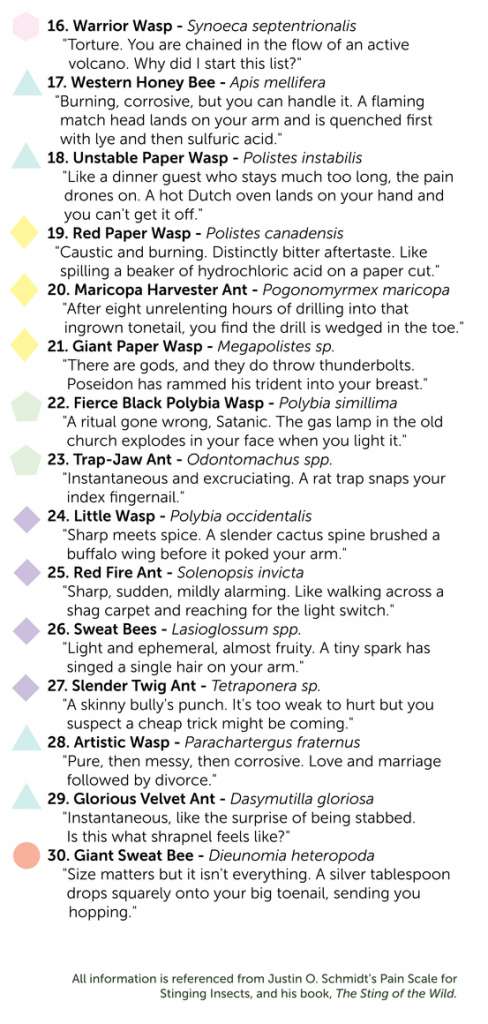Many people exhibit an intense dislike for ”insects,” or should we say, arthropods, that VERY large grouping of invertebrates with segmented bodies and jointed limbs that includes the spider (an arachnid) on the wall, the lobster (a crustacean) on your plate and the butterfly (insect) in your yard.
But, perhaps we should consider that they are pests only from our point of view. There is no other animal group on earth that is as diverse in number of species (99.5% of all animal species), as abundant in number of individuals, and as successful in occupying almost every conceivable niche. In terms of their ability to reproduce and evolve in the face of extreme changes in their environments, they are much more adaptable than any other group.
Arthropods and man are both trying to satisfy the necessities of life, such as food and shelter. Occasionally we come into competition with each other for these resources, or become resources ourselves! To quote Carl Olson, author of Learning About and Living with Insects of the Southwest:
It is the aim of most living things to maintain diversity, and this will then keep a healthy ecosystem. Once greed and selfishness creep into a system, you can bet trouble will soon follow. With insects I seldom find this to be the case. Oh, to the human’s aesthetic taste, insects are destroyers, but to Nature, they are the recyclers, the re-workers and the designers. They’ve been at this game of survival much longer than human beings, and they’ve surely succeeded. – Carl Olson
Day 1 – What is an Arthropod?
ar thro pod, n. [N.L. < Gr. arthron, joint, and poús, podos, foot.] Any member of the Arthropoda, a phylum of invertebrates with segmented bodies and jointed limbs: included are myriapods, arachnids, crustaceans, and insects.
Learn More
An introduction to Insect Orders
Moths and Butterflies
Sky Hunters, The World of the Dragonfly
The Insect Apocalypse Is Here
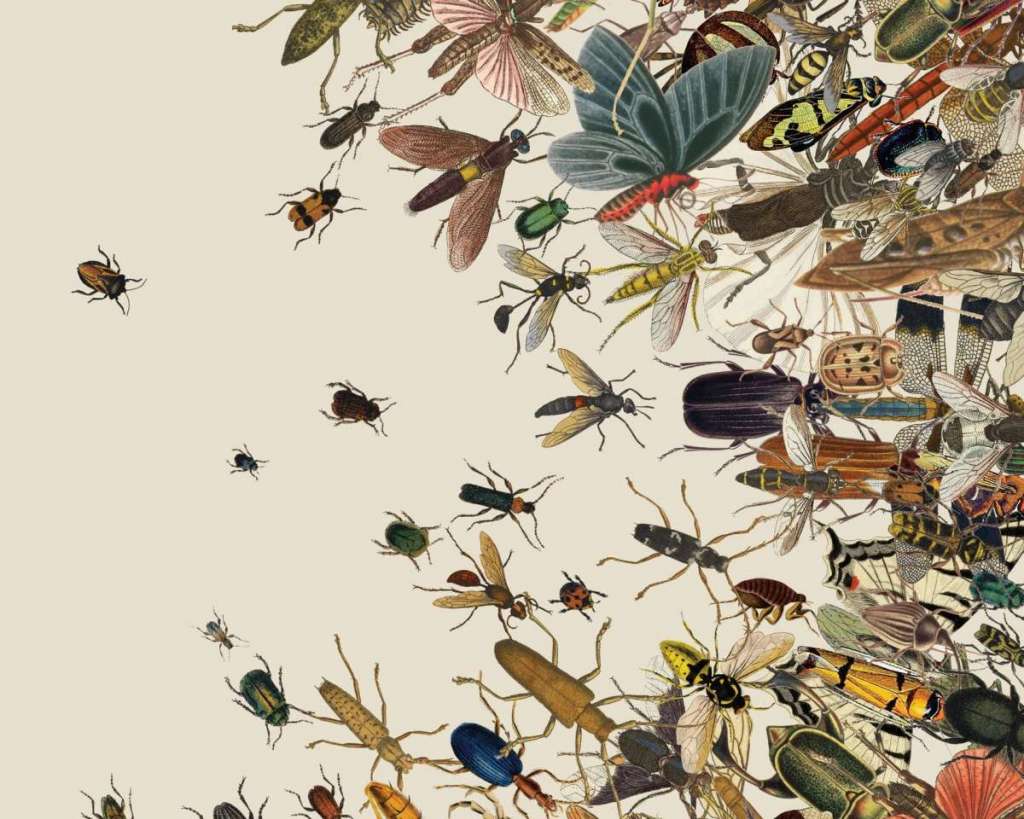
Insecta: Science That Stings
Arizona Insect Festival
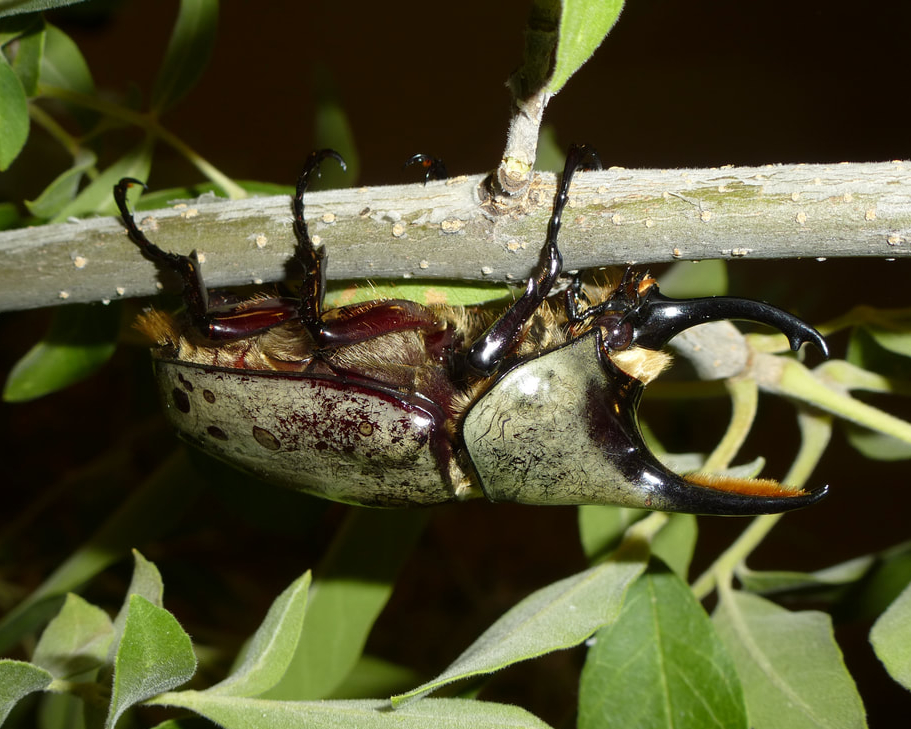
Wowza, That Stings
From ‘Nettles’ to ‘Volcano,’ a Pain Scale for Insect Stings – Click Here To Read The Full Article
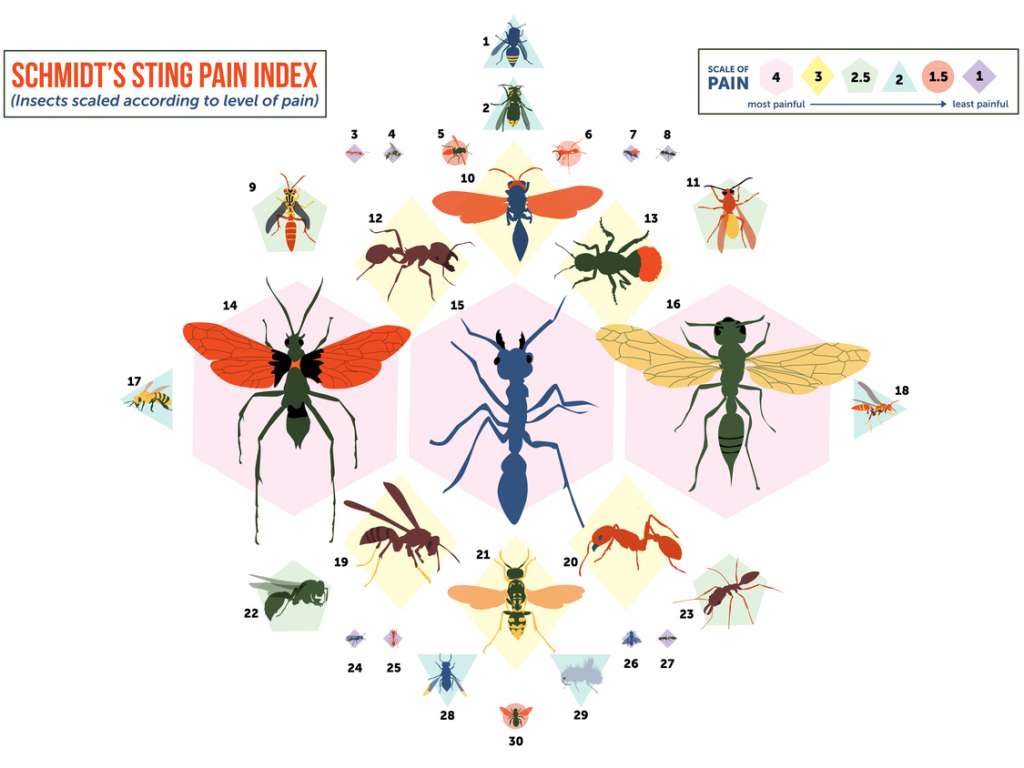
The Sting of the Wild
by Justin O. Schmidt
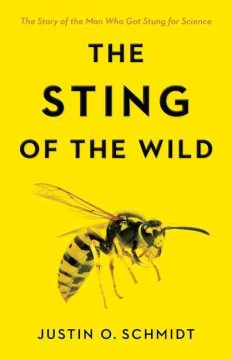
Entomologist Justin O. Schmidt is on a mission. Some say it’s a brave exploration, others shake their heads in disbelief. His goal? To compare the impacts of stinging insects on humans, mainly using himself as the test case.
Get The Facts
Ants
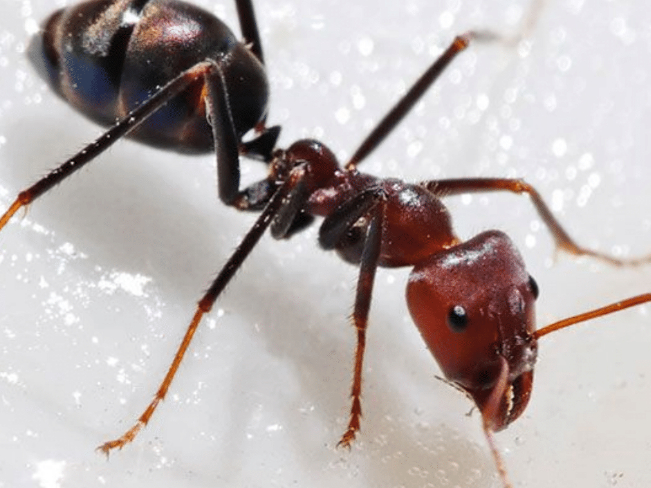
Bees
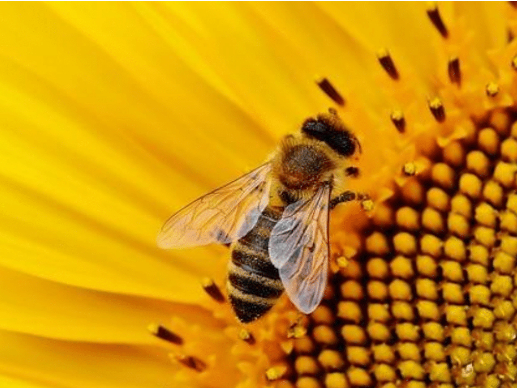
Beetles
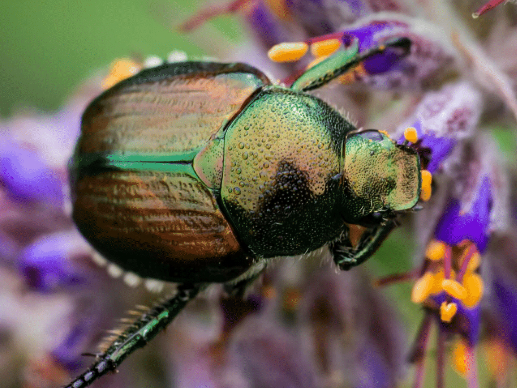
Bugs
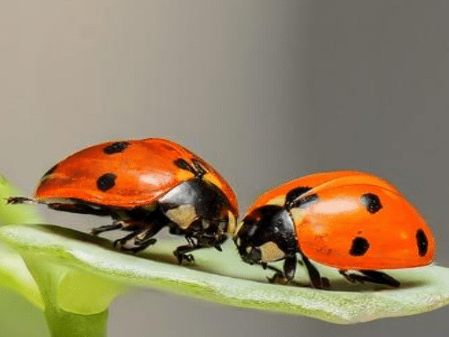
Honeybees
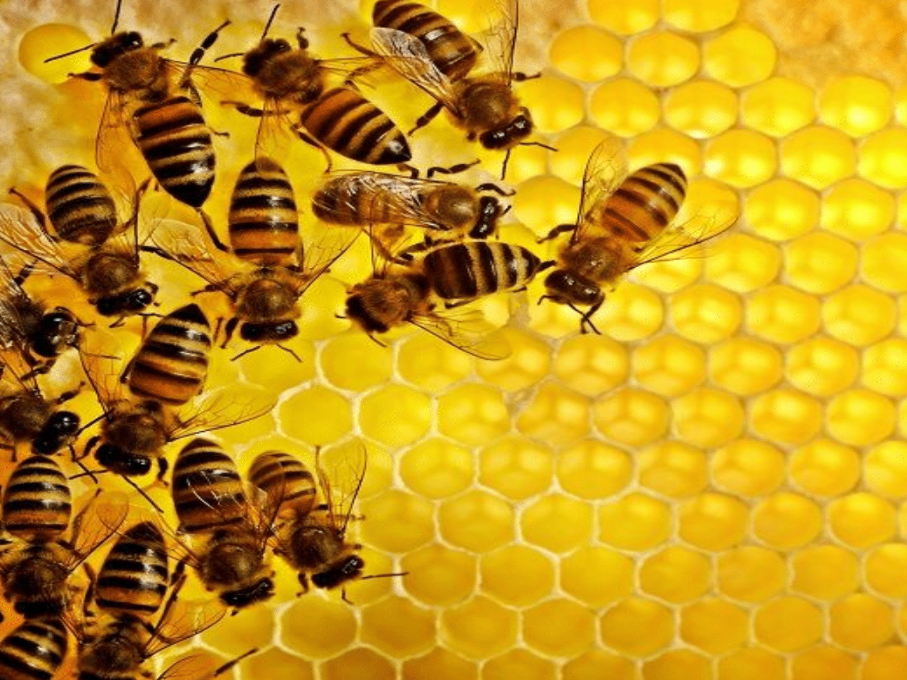
Ladybug
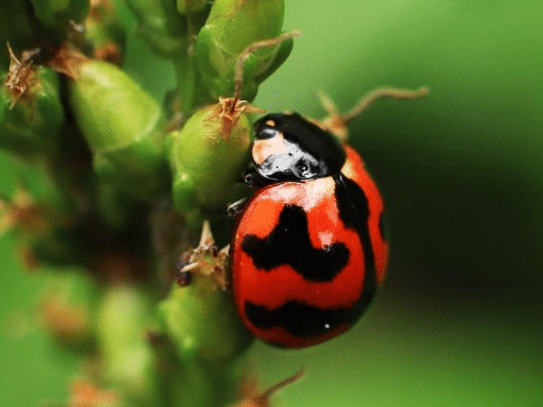
Millipede
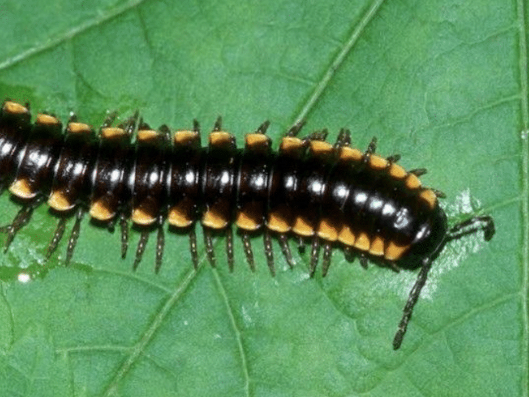
Praying Mantis
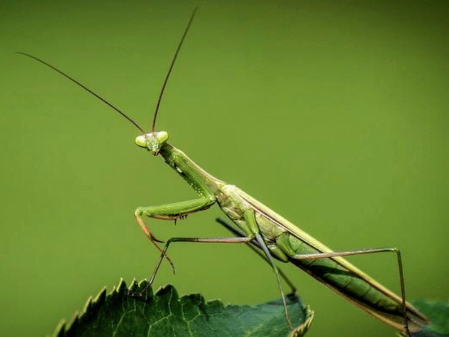
Scorpion
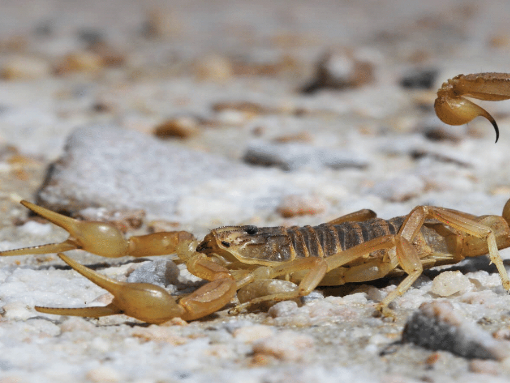
Spider
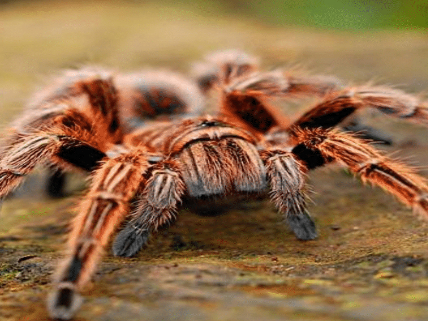
Activity Time

Day 2 – If You Build It, They Will Come
Building A Butterfly Garden
Butterfly Gardening
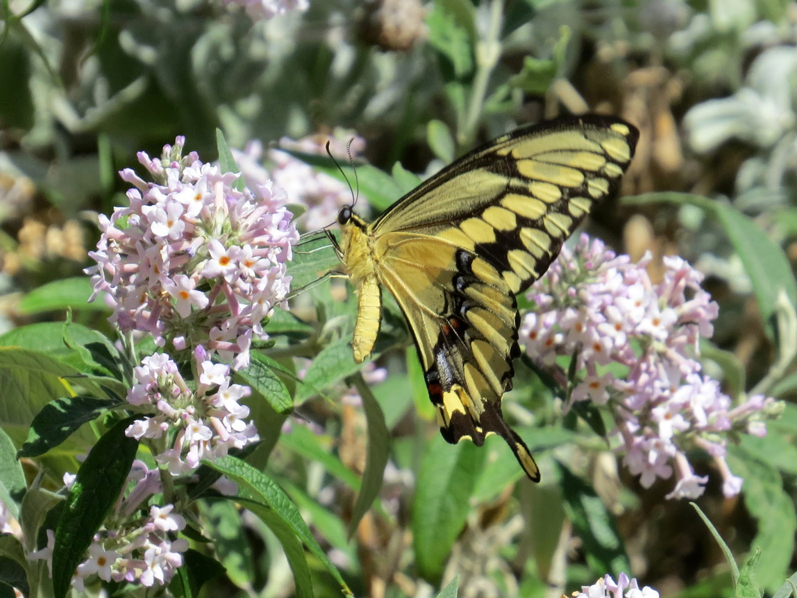
Wild About Butterflies
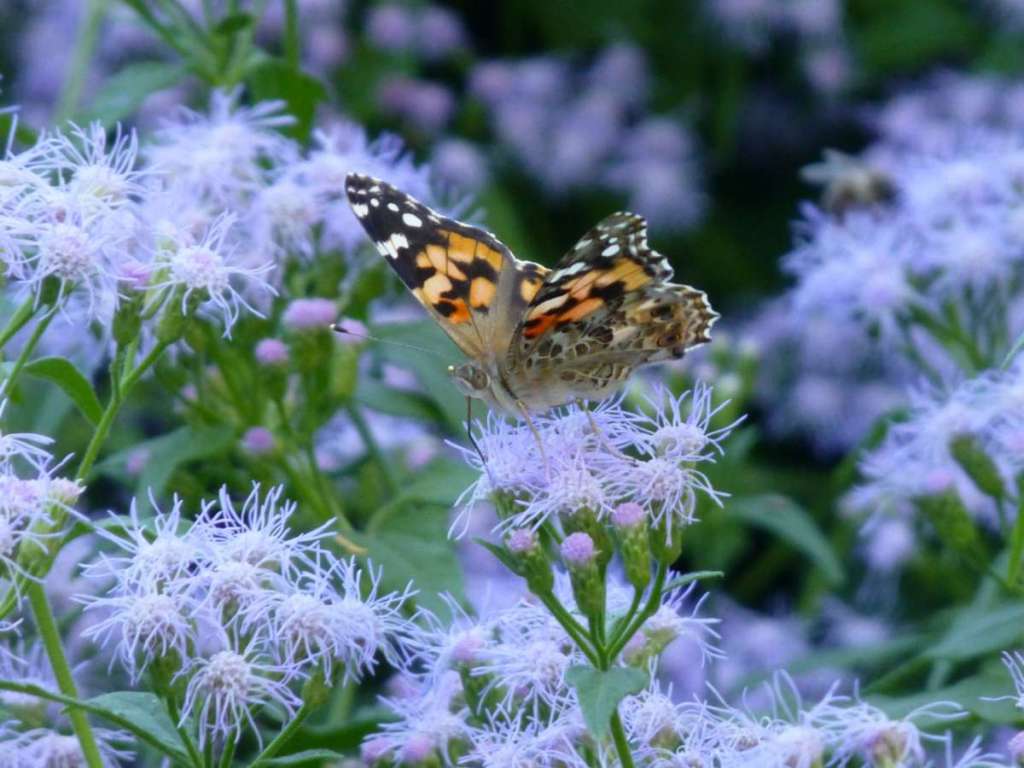
Best Butterfly Plants
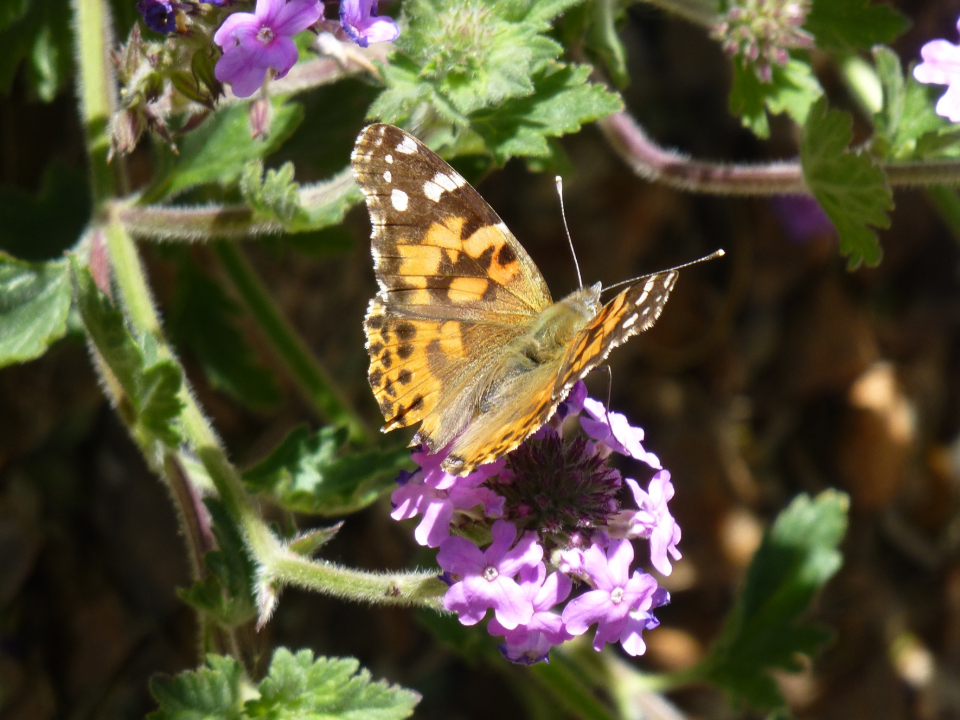
Build A Bee Habitat
Dwelling Place for Anthropods
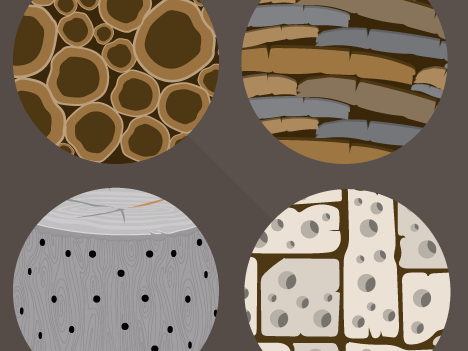
Build a Backyard Bee House
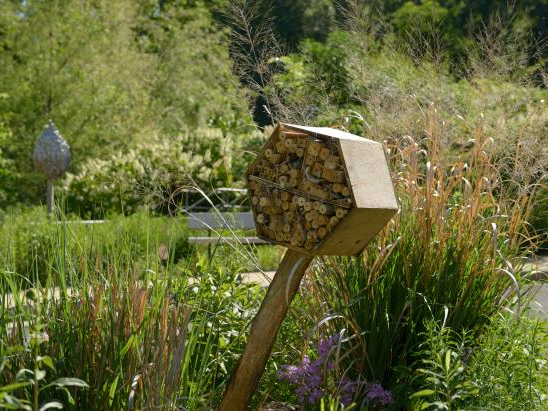
Get To Know Wild Bee Hotels
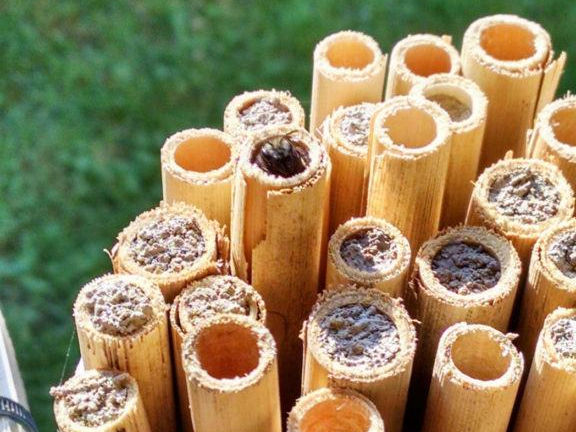
Offering Homes To Bees
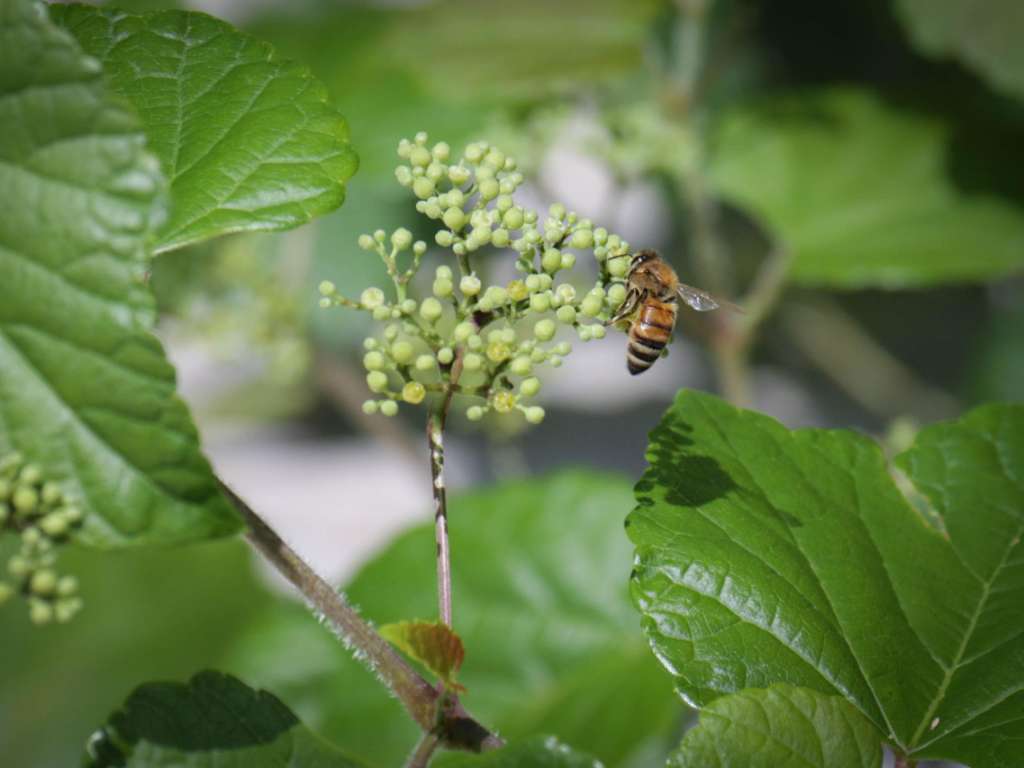
Pollen for Food: A Solitary Solution
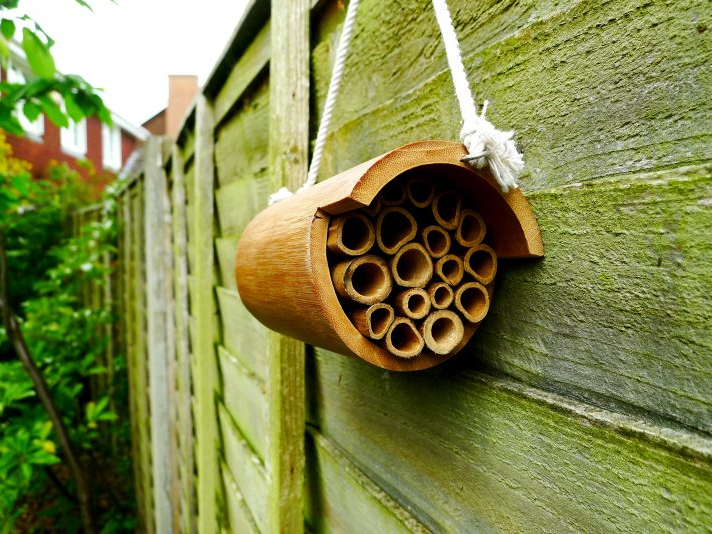
Attract and Identify
BugFinder – Search and ID
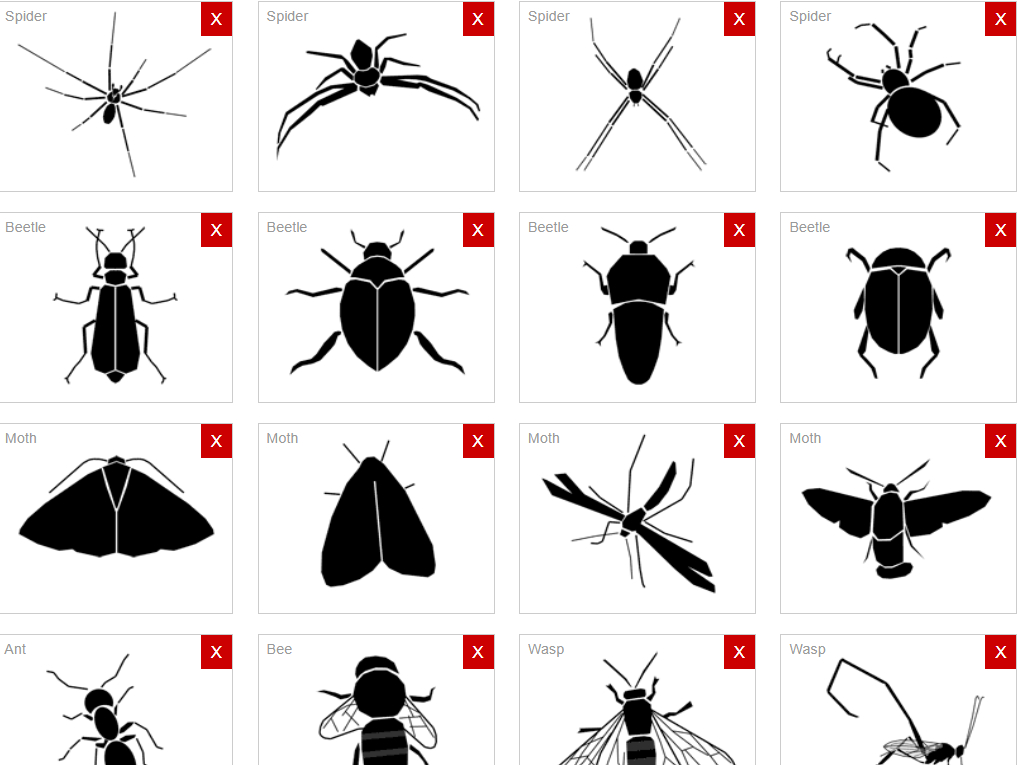
All Abuzz About Bugs!
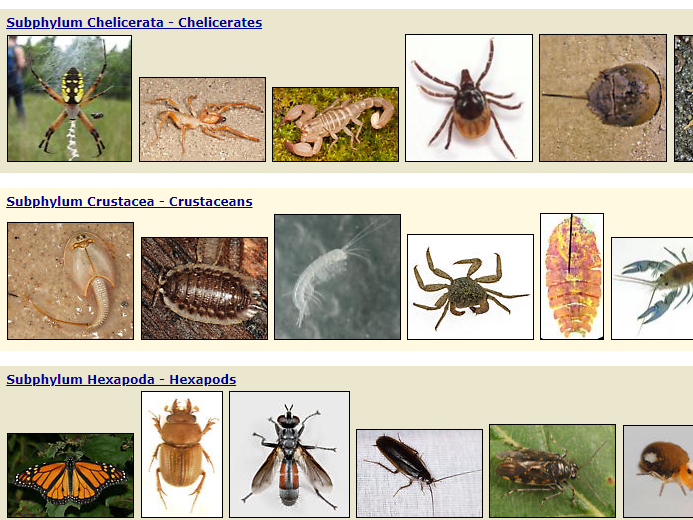
Butterfly Identification
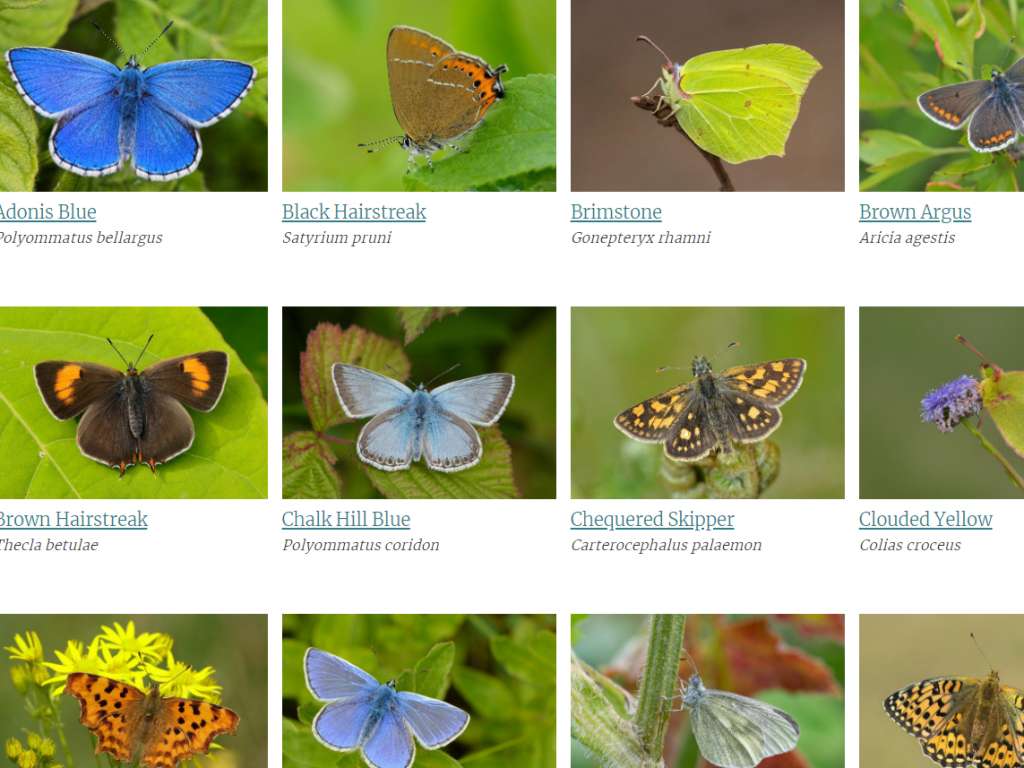
Butterflies and Moths
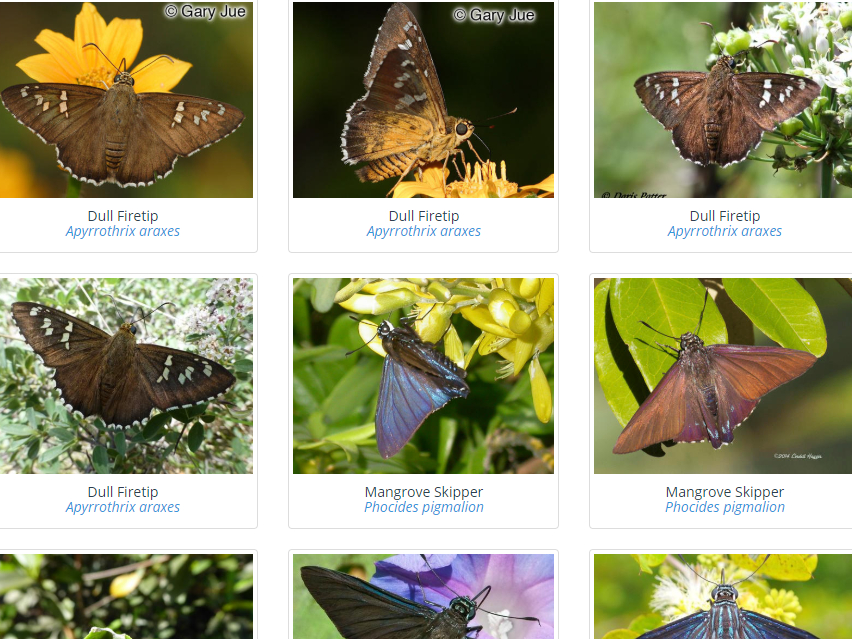
[expand title=”MORE RESOURCES” rel=”fiction”]
Butterfly: A Life | National Geographic
The Stunning Life Cycle Of A Ladybug
Southwest Monarch Study
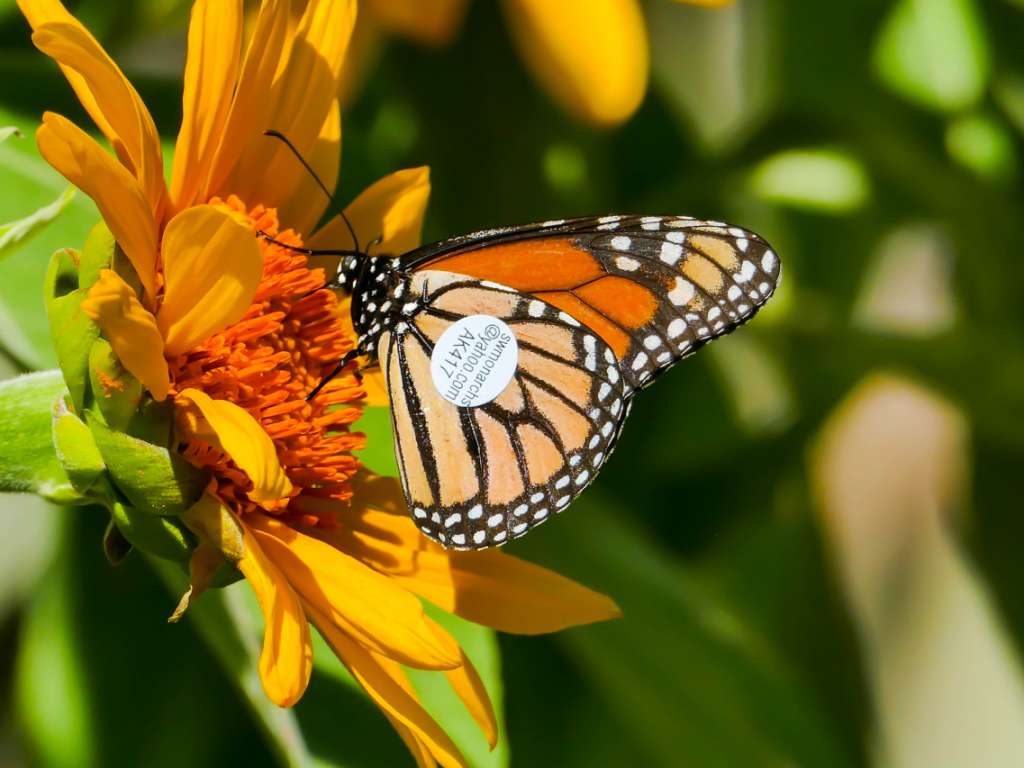
PBS Science Trek – Insects
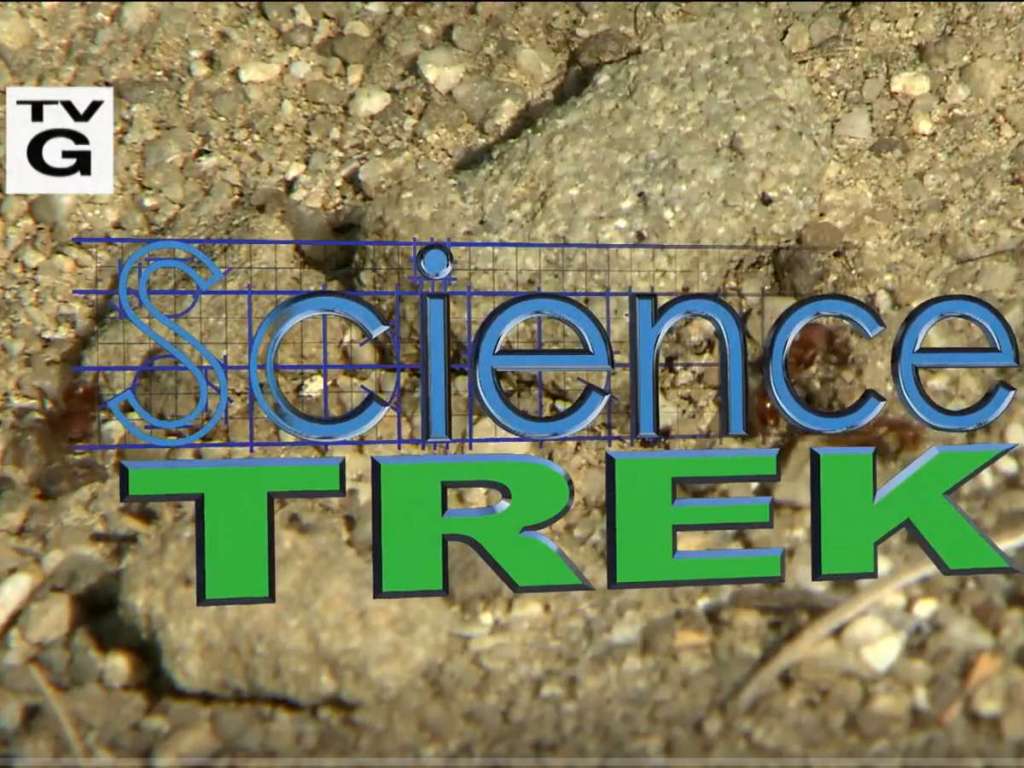
TED TALKS – Insect Playlist!
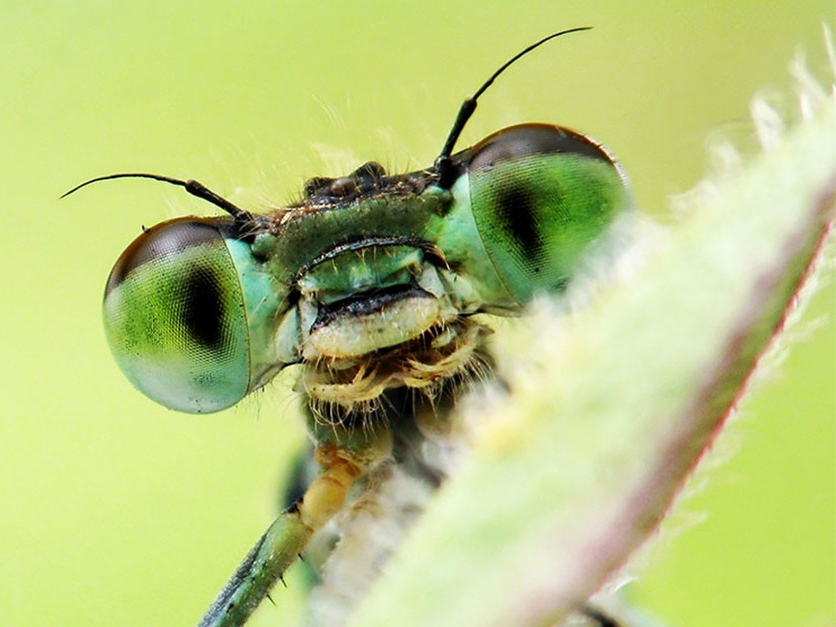
[/expand]
Arthropod Storytime
The Very Quiet Cricket
The Very Hungry Caterpillar
The Very Busy Spider
Day 3 – Artistic Expression
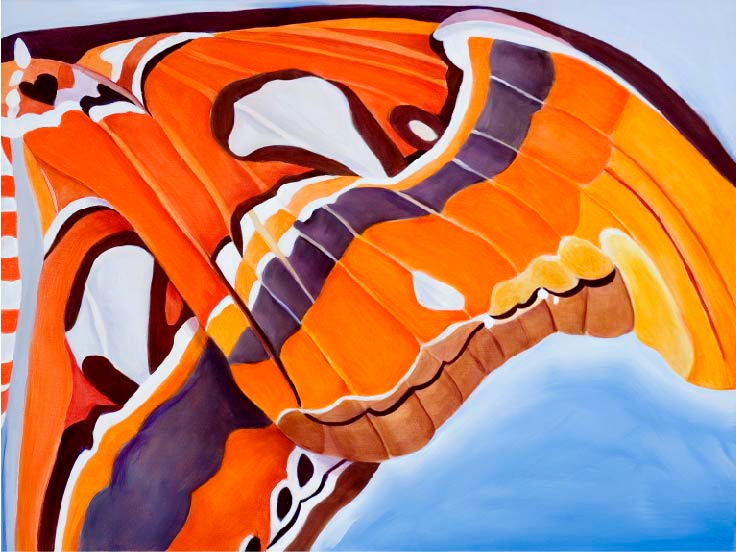
Download this week’s coloring sheets featuring Arthropods!
Enjoy Some Fun and Vibrant Eric Carle Printables and Activities
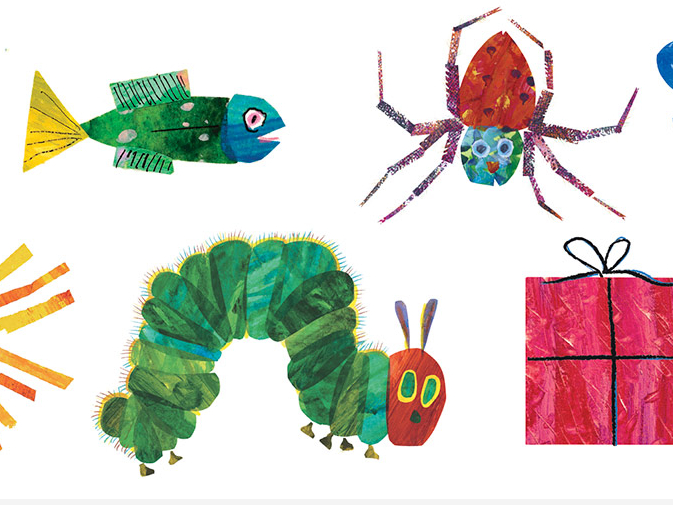
Get To Know The Artists
Gwynn Popovac
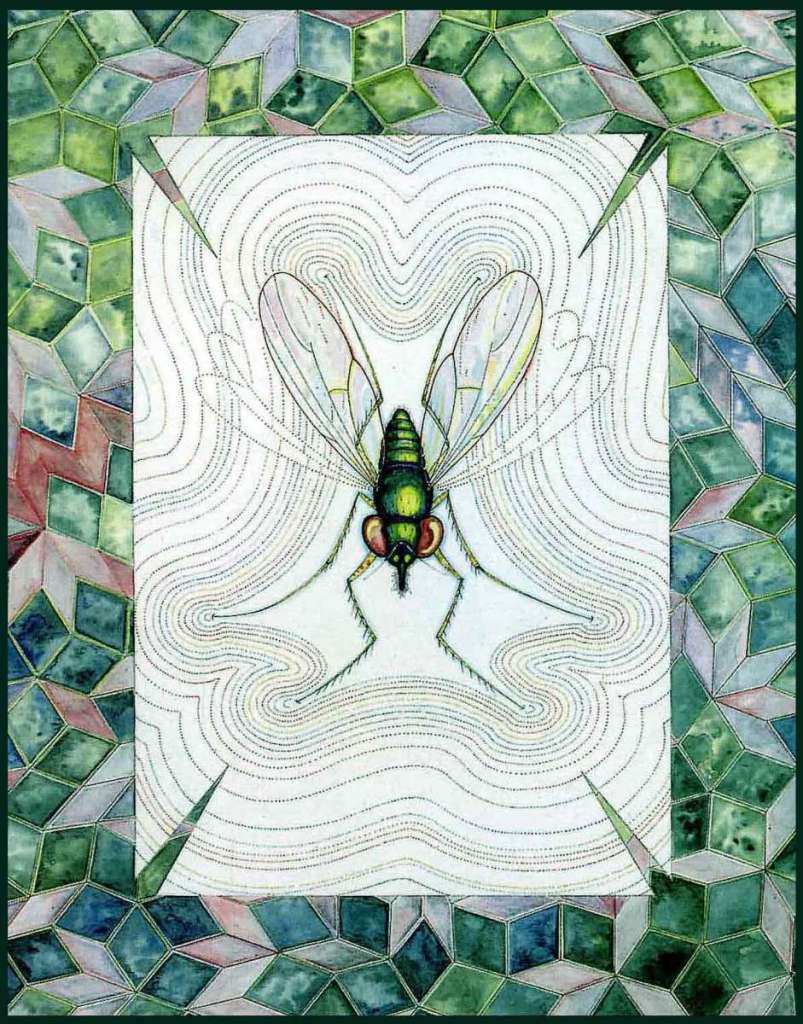
Vibrations of a Long-Legged Fly
“Long-legged flies can be found in wet habitats, running around on the vegetation in search of mates and small insect
More
prey. Their mouths are part spongy bag for securing prey and part chewing, tearing tools. The male performs a slow-motion courtship dance in front of the female. He does not need to offer her a food gift, as many other predatory flies do, because her mouth is too small to be of any danger to him.
Scrutinizing nature, both human and wild. Courting dream visions. Keeping an eye on the ones that are clear, and persist. Trying to capture them by whatever means or medium it takes, without any loss of luster or edge; that is to say, as vividly as a vision was delivered to me and, before the blur of consciousness is cast over it. I am an expert sleeper, specializing in the zones of falling off and waking up and an avid dreamer who loves to share those images I feel are most universal.
I am also engaged with the idea of kinetically charging an image by repeating it throughout a composition, as well as by enmeshing it in a terrain of textural patterns to create gratifying rhythms and reverberations. As though every element must be participating in some grand dance.
Why do some of the insects I draw look like humans, or the humans look like insects? Humans and insects share the same space, move upon the Earth displaying similar needs, urges, desires, and pangs. Playing with the interchangeability of body parts is one enjoyable, whimsical way of expressing this common pulse.
With the exception of temporarily captive insects, I do not use models, or work from photographs. My figures and forms are derived from memory and imagination. And although they are not anatomically correct, I feel I get closer to the spirit of what is human, or the essence of any living thing by this, for me, more direct path; from heart to hand to surface. The same goes for rocks, water, and air….
My mask sculptures are visages of human features blended with the shapes, tones and textures of natural habitats: desert, tide pool, ice fields, meadowlands, etc. In a sense, they are humans mimicking nature, and by looking the way they do, I trust they will offer a fresh vision of us as bio mythic beings, spiritual creatures aware of our essential and inextricable bond with the natural world.
I try not to be overly conscious of aesthetic or symbolic choices as I am rendering a vision. Just focus on each image with the belief that it has a right to exist regardless of any possible meaning it might have for me. Then, when a piece is done, I relish the discoveries and disclosures made by others, which keep opening my eyes.”
Barbara Smith Ott
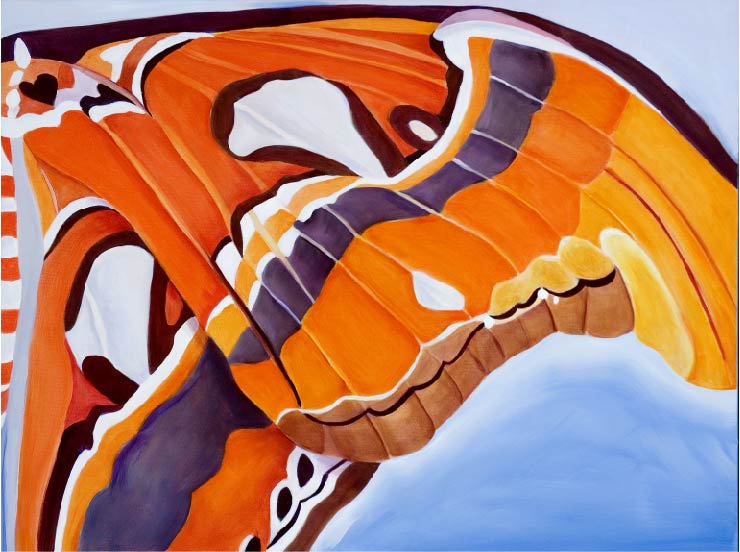
Atlas Moth
“My work is representational but abstract. I focus on color, shapes and composition. With the exception of the studio studies, I tend to paint fast and furiously, alia prima, with passion, a more intuitive process.
More
Painting outside, en plein air, allows me to express how I respond to these scenes in an immediate, loose, and impressionistic fashion. In my current landscape paintings, my creative preoccupation is with the feeling of a big open sky and not much land – this is how I see nature.
Atlas Moth is part of a butterfly series that represents what goes unnoticed, what is taken for granted. Here my concern is with the loss of the natural world. It is more contemplative and for me invites introspection. I am stopping and taking a close-up look at nature’s design, abstract forms and shapes.”
Brooke Molla
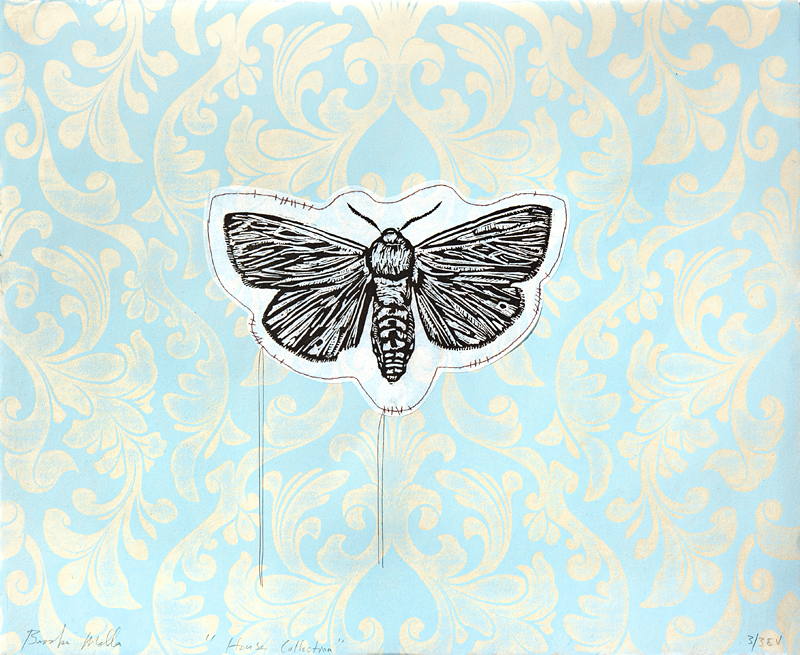
House Collection (Blue)
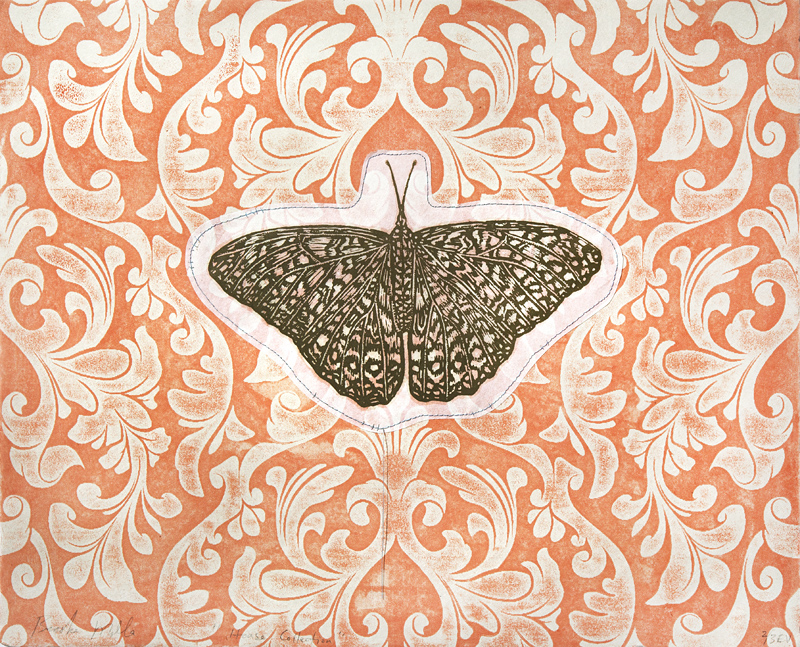
House Collection (Red)
“House Collection is a series of prints that explores the animals and insects of the unseen natural world. Many creatures of the desert only come out at night especially in the summer. We don’t see them but we can hear the screaming of a cat being caught by a coyote or remnants of moths and insects under the porch light to attest to the nocturnal drama.”
More
Brooke Molla is an artist living in the low desert of Arizona. She creates landscape paintings of the bits and pieces of nature that she finds at her feet. These insignificant remnants of insects, seeds and leaves are clues to an unseen world that constantly moves around us. We very rarely see this drama but we do see what is left behind like the pieces of an insect in a spider web or finding a dried up baby bird at the base of a palm tree.
Brooke Molla studied printmaking at Washington University in St Louis MO. Her work is in many private collections and can also be found in special collections in libraries and museums.
Jay Suchland
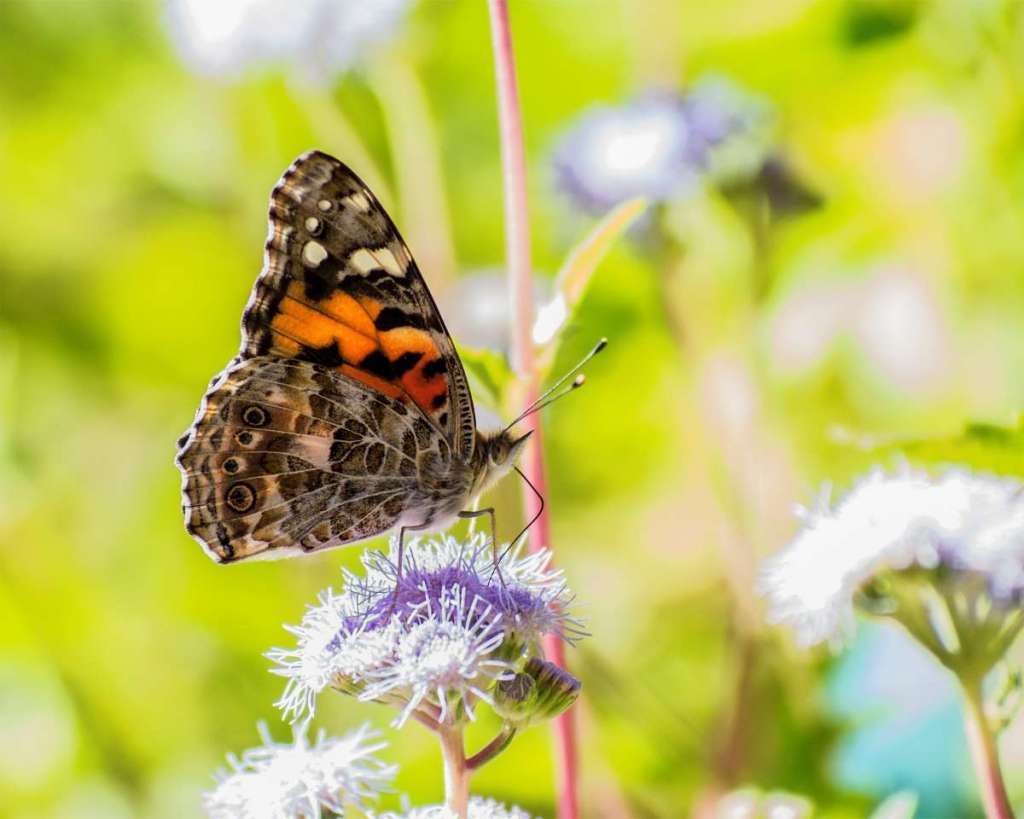
Flora n. 3
“As I studied the work of other photographers, I began to want to have more to say with my images, to capture and convey the essence and sense of place or of a compelling subset of details within a
More
broader landscape. This work represents some of the marvelous details one discovers when focusing on the smaller elements within a landscape. A closer look may reveal pollen-laden anthers within a flower made purposefully beautiful to attract just the right pollinator. On the other hand, it may present a butterfly posed in a floral landscape from a Monet painting.
My fascination with photography began while serving in the military in Europe where I had access to a photo lab and began developing and printing black and white film and shooting color using a Kodachrome slide film. The experience of living and traveling abroad shaped my early efforts and kindled a keen interest in people and places. That fascination has continued throughout my life as I travelled to many corners of the world. Often visiting and now living in the American Southwest has expanded my interest to landscapes and the component details within them including the flora and fauna of the area.”
Lynette Garcia
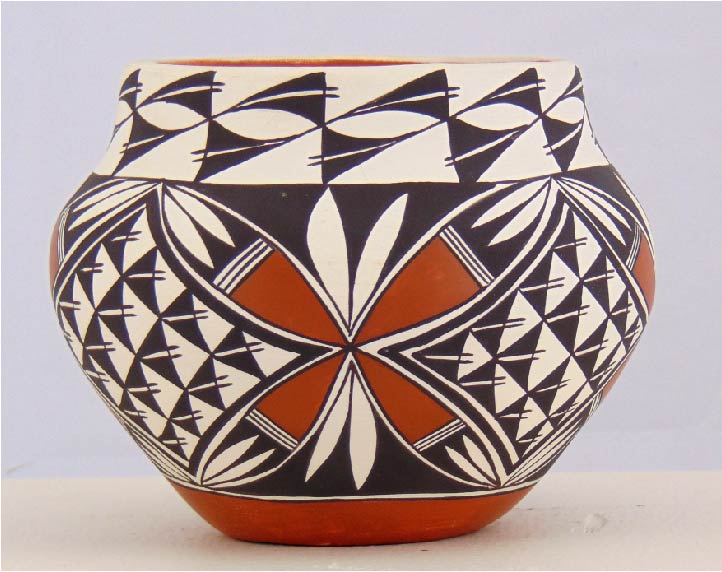
Pot with Geometric Design
The Acoma are known for their distinctive clay which yields white pottery. This thin-walled olla-shaped pot is decorated with vegetal paints in geometric designs with four stylized butterfly designs. The Acoma
More
people, who call themselves, People of the White Rock, live in Sky City, New Mexico where they have maintained residence for hundreds of years. Traditionally, women created pottery but as the market grew, men have also learned the traditional craft.
Loretta Garcia, “U-Wi-Nit”, was born into the Acoma Pueblo in 1956. She was inspired and encouraged to learn the art of pottery making by her Mother, Marie Torivio. Marie taught Loretta all the fundamentals of pottery making, the traditional way, from start to finish. She was also economically motivated to make her pottery.
Loretta specializes in hand coiled traditional pottery. She gathers her clay from sacred ground within the Acoma Pueblo. Loretta soaks the clay, cleans, sifts, mixes, hand coils, shapes, paints, and fires her pottery, outdoors, with pottery shards and manure. She hand coils many different shapes and sizes of pottery. She paints geometrical and traditional designs on her pottery.
Unknown Hopi Artists
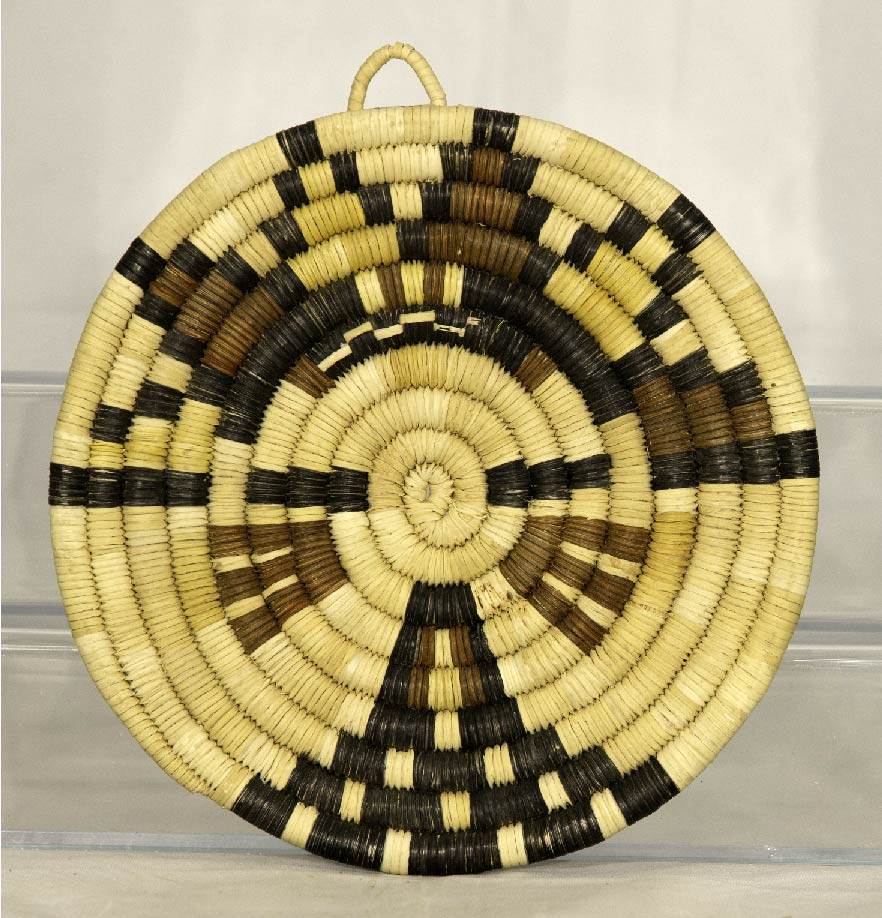
Coiled plaque with Palhikwmana Design, Butterfly Maiden Design
A flat basket like this one is called a plaque. This colorful plaque has the Hopi katsina Palhikwmana or Butterfly Maiden design.
More
She generally appears in August, when the butterflies appear. The Butterfly Dance, a traditional social dance of the Hopi, in August after the gathering of the harvest and presentation of the Snake Dance. It is a thanksgiving dance for the harvest, chiefly for the corn crop and features dancing by young Hopi maidens wearing elaborate headdresses. She dances with her bangs hanging over her eyes. The colorful tablet, or headdress, makes her a popular subject for carvers. Her name comes from the Hopi words paala, meaning juice, and hikwto, meaning to drink, comes together to be Palhikwmana, one who drinks nectar.
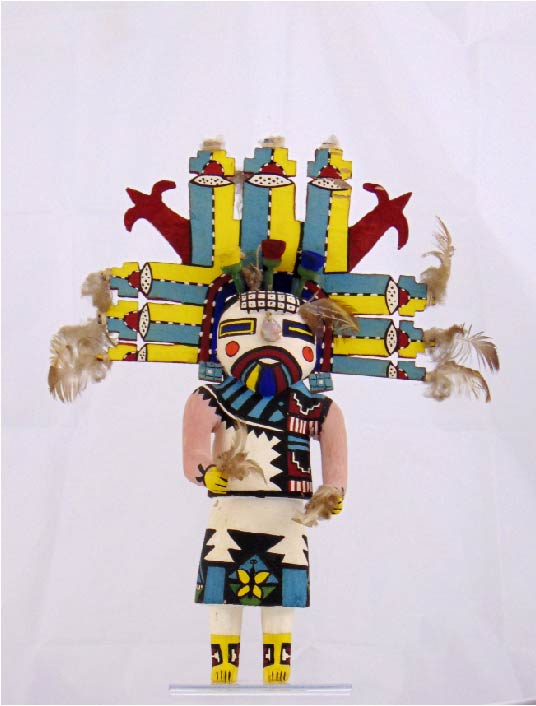
Palhikwmana Katsina, Butterfly Maiden Katsina
This colorful katsina is the Hopi Palhikwmana or Butterfly Maiden. She generally appears in
More
August, when the butterflies appear. The Butterfly Dance is a traditional social dance of the Hopi in August after the gathering of the harvest and presentation of the Snake Dance. It is a thanksgiving dance for the harvest, chiefly for the corn crop and features dancing by young Hopi maidens wearing elaborate headdresses. She dances with her bangs hanging over her eyes. The colorful tablet, or headdress, makes her a popular subject for carvers. Her name comes from the Hopi words paala, meaning juice, and hikwto, meaning to drink, comes together to be Palhikwmana, one who drinks nectar.
Day 4 – Artistic Interpretation
A conversation with photographer Charles Hedgcock and James Schaub, Tohono Chul Curator of Exhibitions
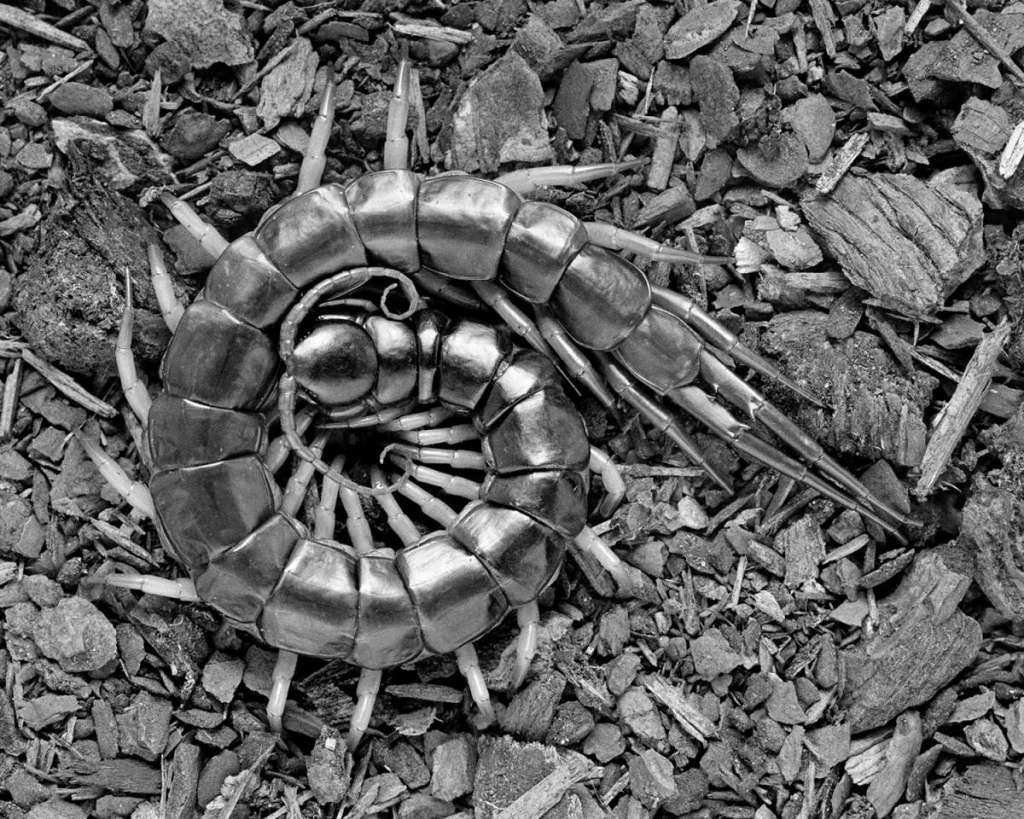
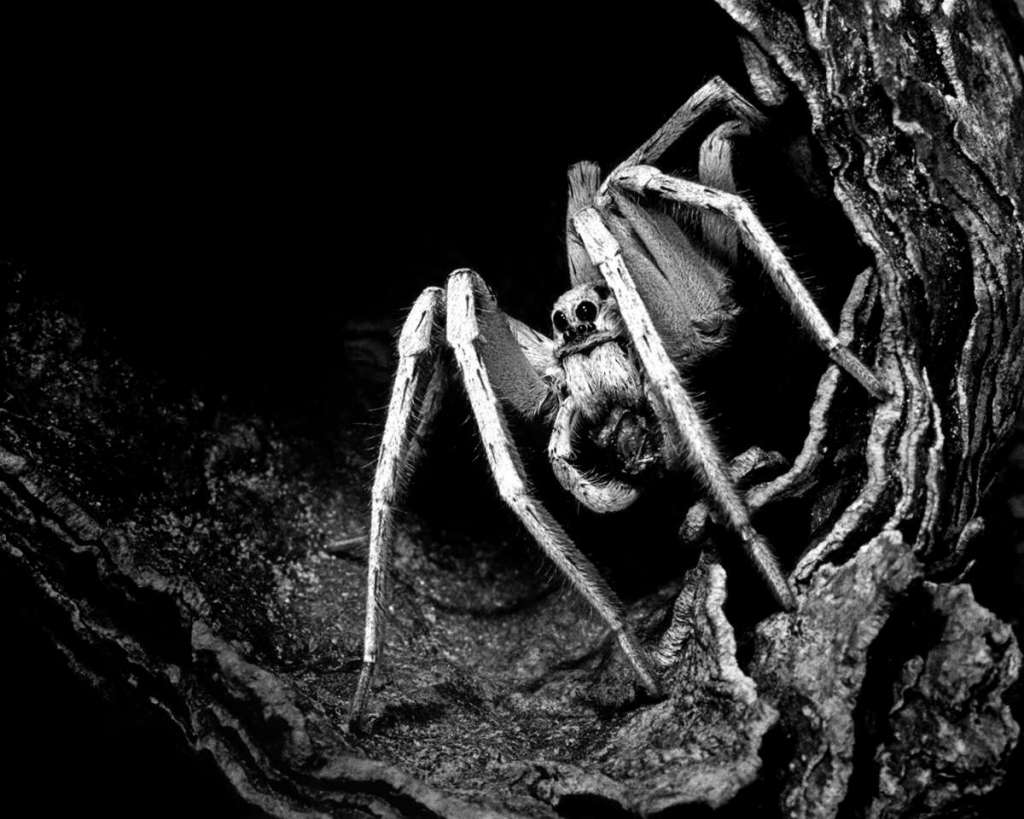
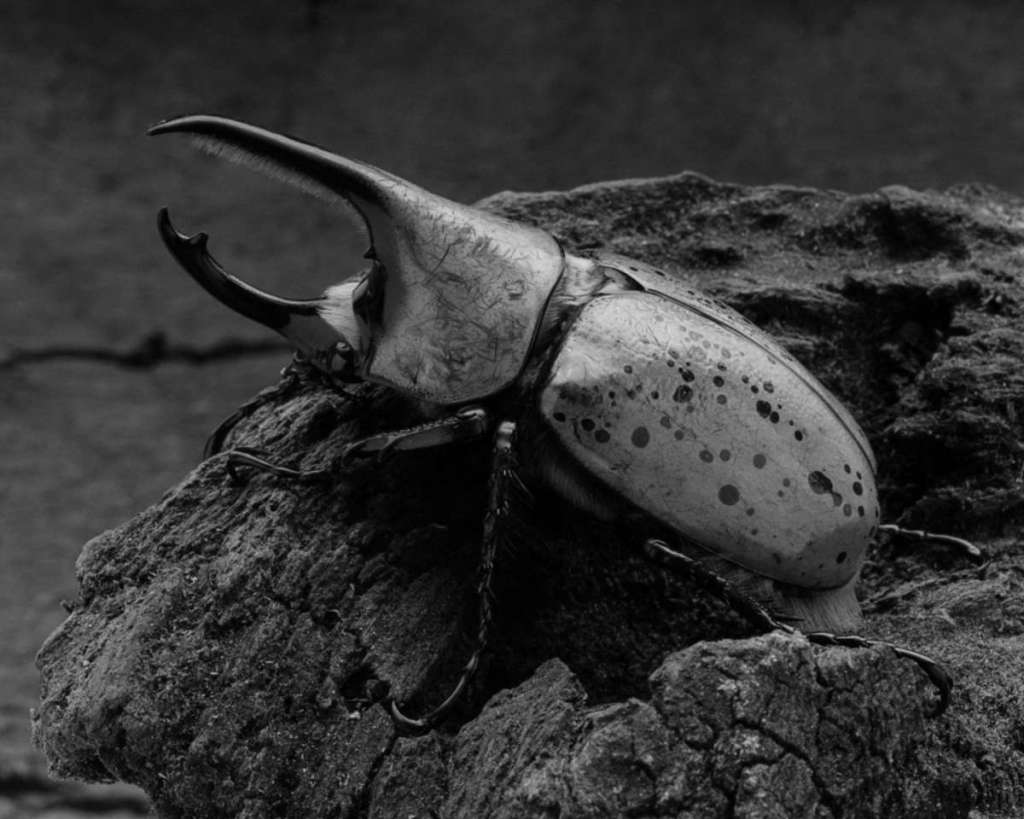
Looking at the images Charles Hedgcock has created over the past twenty plus years I get the impression, almost immediately, that he approaches any and every subject with equivalent and intense scrutiny. No matter the size, no matter the complexity – he knows how to look at things, and maybe most importantly when and where to find them. Hedgcock focuses on the small, often overlooked, things in this world – “I am a Natural Science Photographer in vocation and avocation. My predominant area of photographic interest is small animals and especially arthropods- insects, arachnids, crustaceans, millipedes, centipedes- the things most people step on.” – add to that list the plants that he has been concentrating on for the past few years and you have a very good idea of where his interests lie. Look at his work reflectively and you find yourself drifting through the image toward the essence of his subject – “The life history of these tiny animals- birth, growth, reproduction, death- is life’s history. A close inspection begets a closer inspection still; life’s drama is played out on a micro scale.”
[expand title=”READ MORE” rel=”fiction”]
The idea of es·sence (/ˈesəns/. noun . the intrinsic nature or indispensable quality of something, especially something abstract, that determines its character.) and a “life history” also apply to the subject of photography for Hedgcock. His interest in and love of the medium is a subject unto itself; the interconnectedness of Hedgcock’s life history with those of his treasured animal and plant subjects is fascinating. His dedication to the history, science, and art of photography is apparent in each image. A skilled craftsman and technician behind the camera and in the darkroom, Hedgcock’s photographs demonstrate his reverence for the craft and serve, on a multitude of levels, as a document toward “life’s history,” all the while providing an entrance into the essence of what truly goes into making any object of art.
Upon my introduction to his work, it was clear to me, that it is in ‘the making of things’ where Hedgcock excels. Whatever it is he is working on you can bet it is well conceived, finely tuned, and pristinely presented. Going back twenty years, a series of gelatin silver prints had me looking at arthropods in a totally different way, in a totally different light. They were striking, perfectly illuminated and printed – gleaming with an incredible range of glistening highlights juxtaposed against cavernous dark recesses. I responded to their strong compositions that emphasized the center. Working with live creatures added to the naturalness of their positioning, placement, and arrangement. I admired their seeming simplicity of figure to ground – the variegated background – a shallow space that hinted at an environment; the contrast in texture, value, and sheen that held, yet pushed the bold sculptural form of the arthropod forward. It was as if you were not even looking at a creature but a sculpture of one. The hard articulated joints and edges conjured the hardness of metal – an armor plating: hammered, shaped, carved, etched, chased, buffed and polished. I imagined Hedgcock in the darkroom giving volume and form to the light coming through the enlarger, honing his skills as Master Printer but also as a Gelatin Silversmith, if you will.
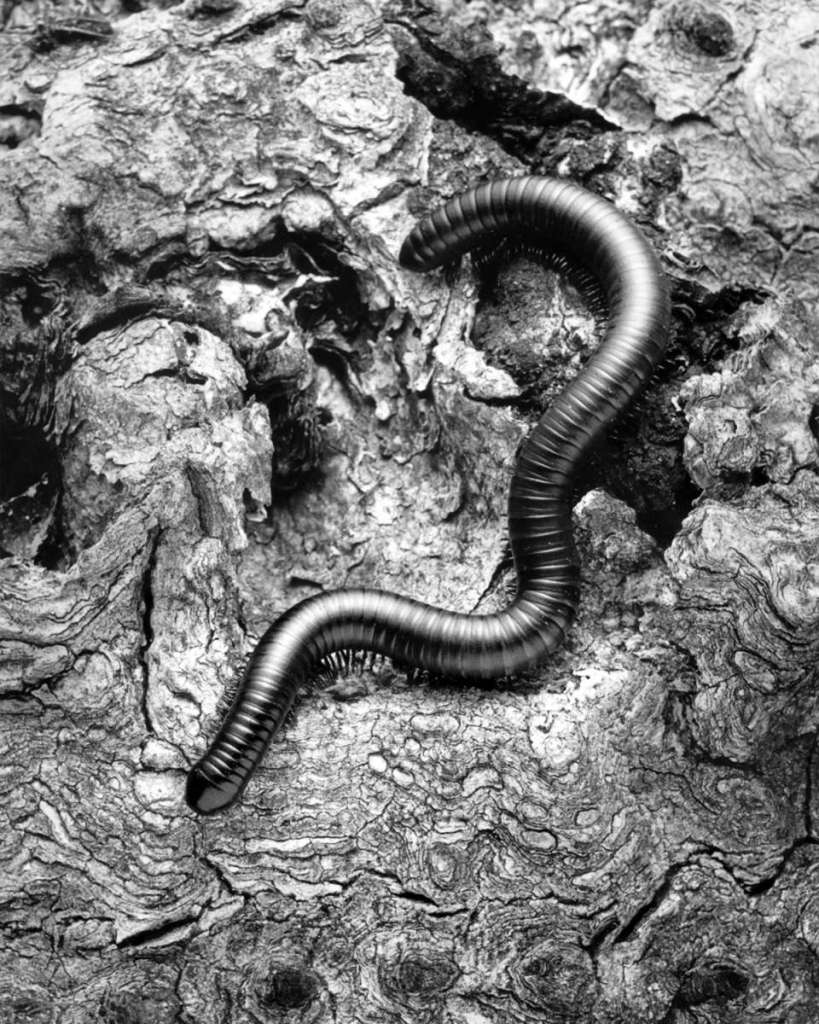
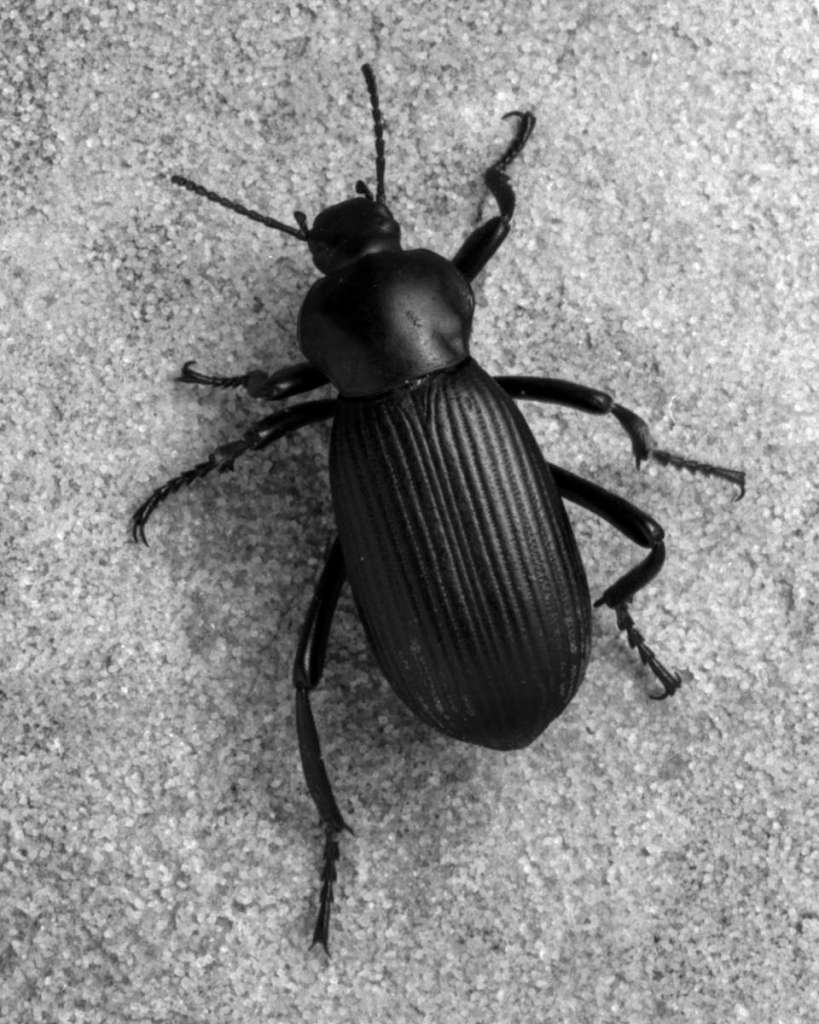
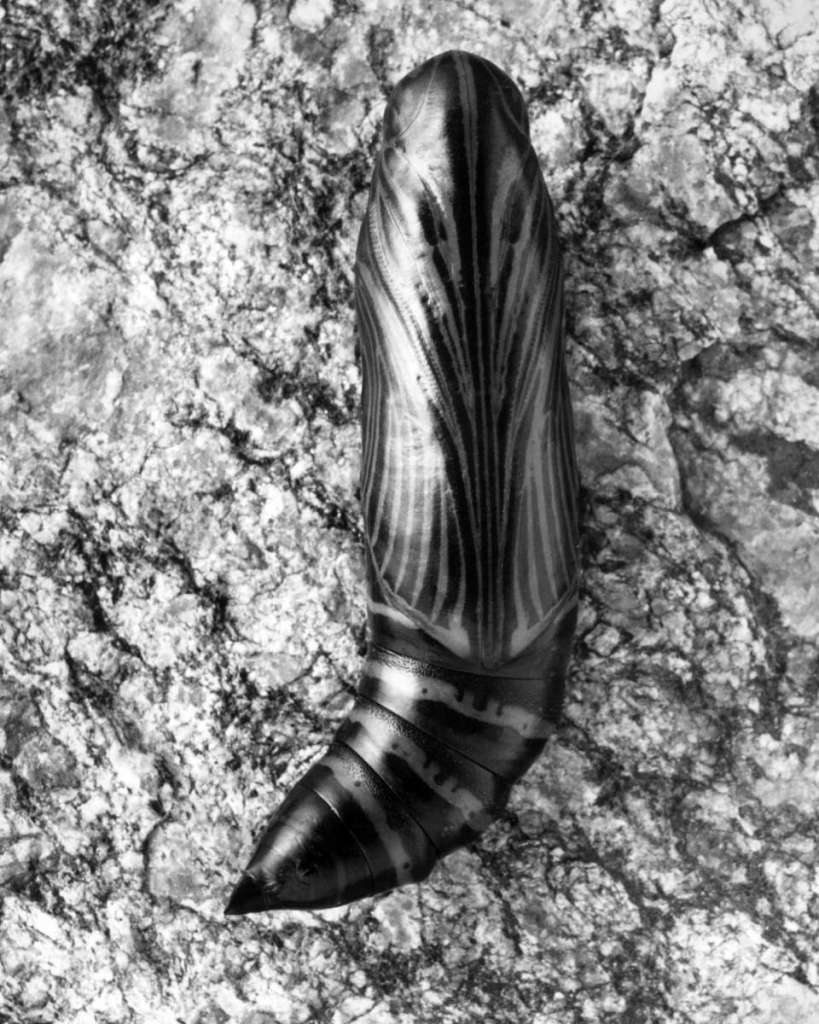
Photography’s gelatin silver process has been around since 1871. As a photo student in the late 1970’s and early 80’s, Hedgcock, learning everything he could, cut his teeth on the process. Contact prints, trial prints, and experimentation take its toll on a student’s psyche, determination, and budget; especially is you are encouraged to work as a professional from the get go. As a student you are often instructed to use the best equipment and materials possible – not having to battling inferior tools and supplies, you are able to acquire an enhanced sensitivity for what you are capable of and develop an awareness of how things come together. And, do it consistently, Velox photographic paper was invented in 1893; in 1899, the Eastman Kodak Company bought the original manufacturer and started to produce it as theirs. Velox was marketed to appeal to the student – the ‘amateur photographer.’ Kodak ceased its in 1968. Starting school when he did, I am guessing Hedgcock would not have used Velox unless he found a stash of it in an old, dusty, forgotten chest of drawers or closet.
Oh, wait, that did happen.
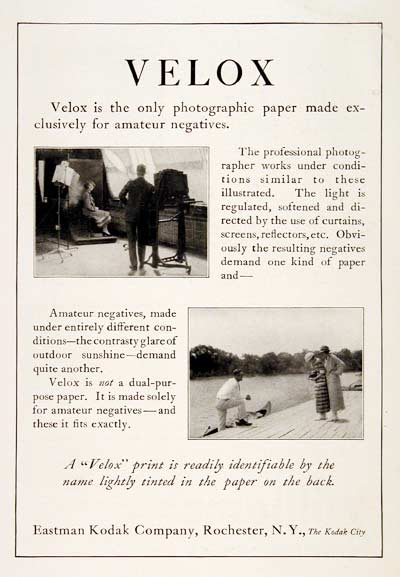

Flash forward to 2013/2014 –Tumamoc Hill in Tucson, AZ. Hedgcock, part of a group of artists working on site, is trying hard to capture the history and essence of the place. He is having no luck, things don’t feel right. And then, As Hedgcock recounts, fellow Tumamoc artist Paul Mirocha “showed me a moldering pile of slim yellow boxes, and suggested – “Maybe something cool could be done with this stuff.” Among the water stained boxes, was a partially filled box of long expired “Kodak Velox Paper, #2”, a black and white photographic paper, dating from the 1960’s. An aged remnant from the tiny, primitive, and long abandoned darkroom that once served the staff on Tumamoc Hill.” Understanding materials like he does, Hedgcock recognized the challenges the unstable paper presented but also saw the possibilities it had to convey the sense of place he had searched for from the beginning of his residency. He went right to work “This paper, pressed under glass with an exoskeleton, plant cutting or feather, found on the hill, is left in the Tumamoc sun. Many hours of solar exposure cause the paper’s gelatin silver emulsion to gradually change color. After fixing and toning the delicate paper in my darkroom, I am left with a subtle negative image, whose rich reddish-brown color, exactly matches that of the volcanic stones making up Tumamoc and its quaint, historic buildings. These unique, one of a kind images are called “Lumen prints” and help me express the story of Tumamoc Hill.”
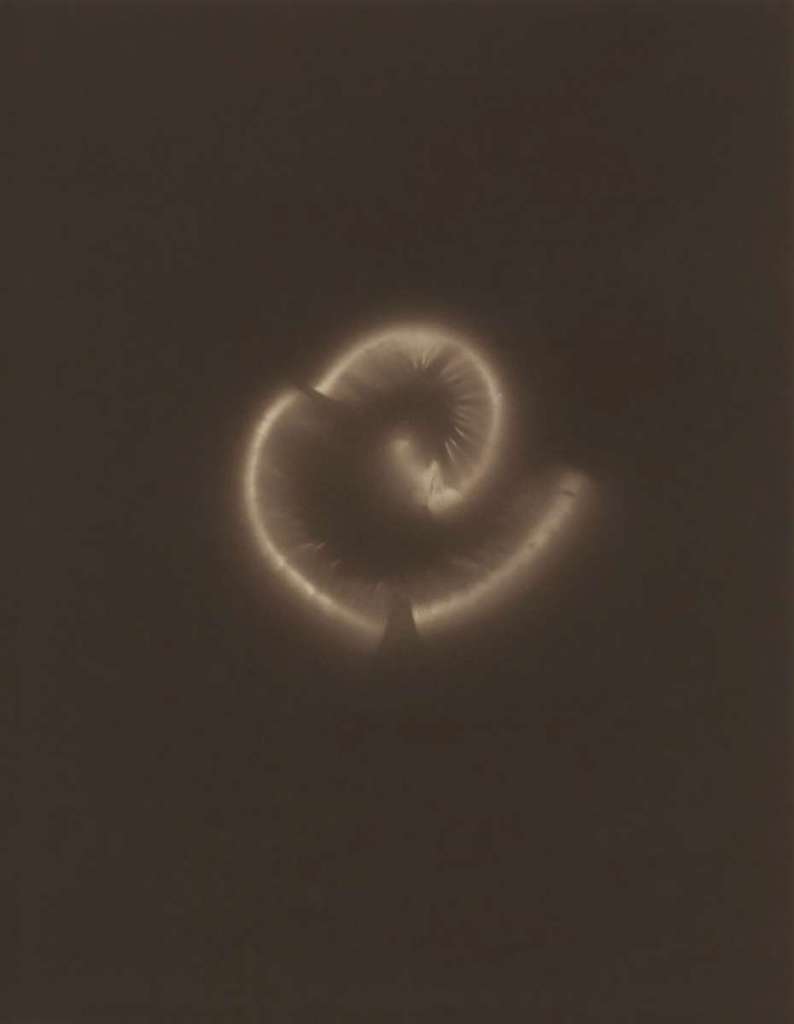
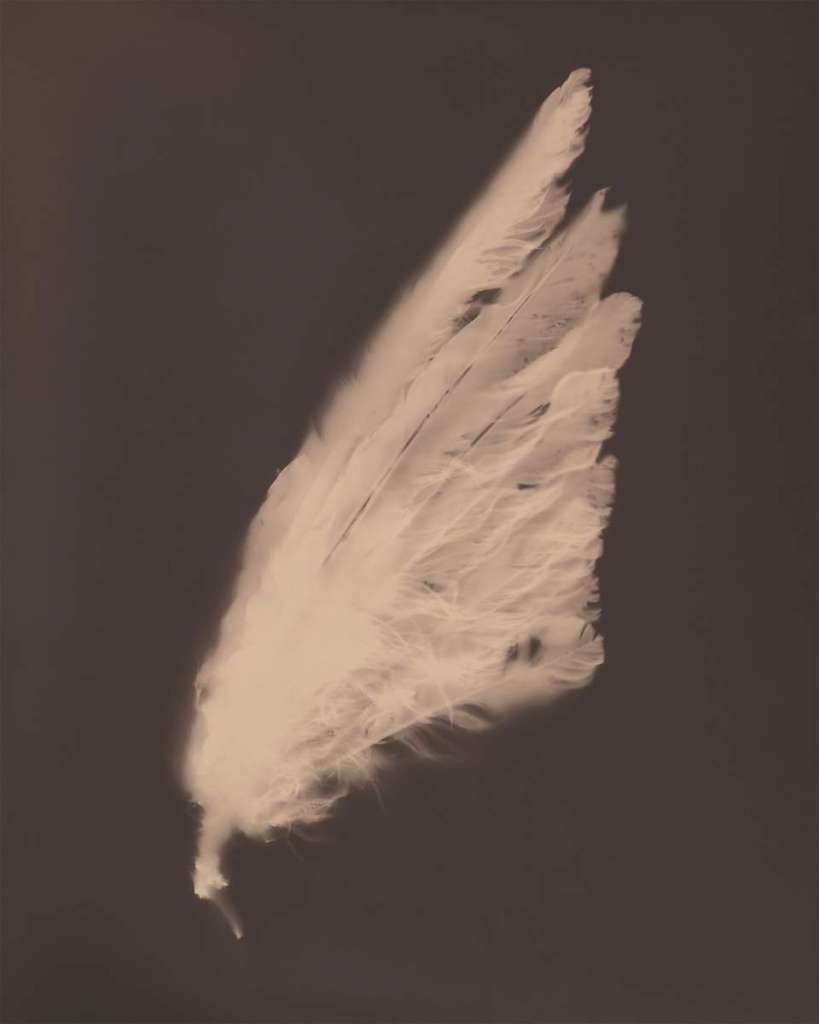

The prints that came off of Tumamoc Hill borrowed the same central composition with his gelatin silver prints. However, that is where the similarities end. The hard edges, metallic luster, rich value, dynamic contrast, sculptural solidity, shallow space, and crisp detail present with the living arthropods all vanished – replaced by forgotten ethereal forms, hushed, softly focused, and floating on an amorphous purplish, ruddy, dark bronze field. They too were striking; but, being so muted, they became more mysterious and harder to explain. The unstable emulsion and the unpredictability of even keeping an image in tact after the darkroom was more than just a ‘cool’ discovery it became an entrance to a new way of working.
Hedgcock’s lumen prints atop Tumamoc Hill led him to explore the process further utilizing plants from the region. Using the same unstable paper, this time he allowed even more things happen to the emulsion. The interaction of the plant enzymes and atmospheric conditions inside the assembly of glass, plant, and paper mingled over several hours or days with the sunlight oxidized silver salts. As he took the assembly apart and pulled the paper from the plant matter, Hedgcock marveled at the uniquely detailed, colored, stained, collaged, and textured prints – it was an epiphany. Remember, he know how to look at things – the process must be documented! To capture that moment of unpredictability, immediacy, elegance, and essence Hedgcock began digitally scanning the pieces before they were fixed and toned.
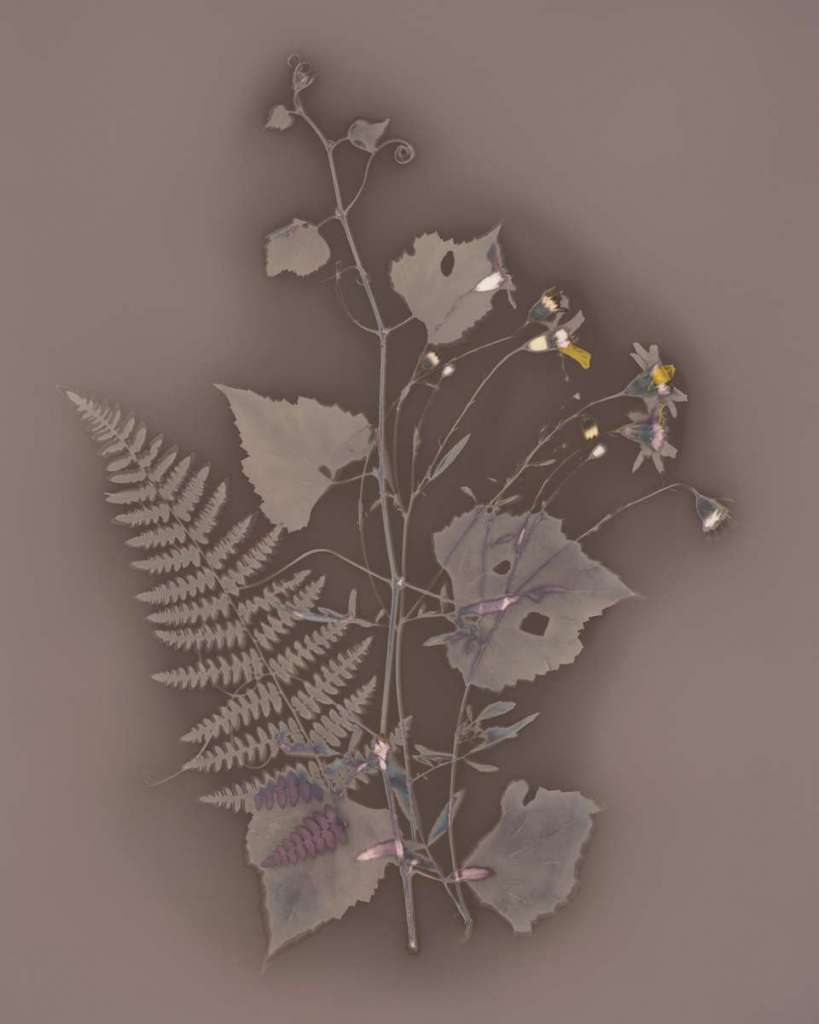
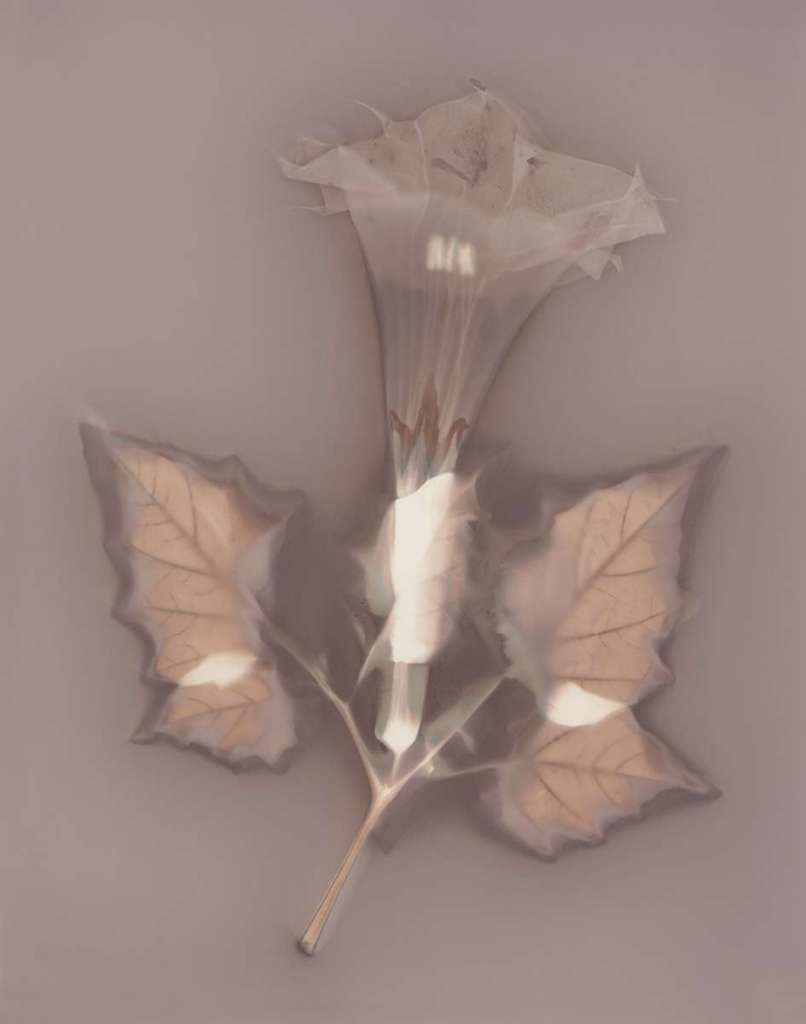
Charles Hedgcock is a frequent contributor to the exhibitions at Tohono Chul. He was a Tohono Chul . Featured Artist (2012). His first series of lumen prints were featured in Tumamoc Hill: Art, Culture and Science (2014)and IN FULL BLOOM (2016). Charles Hedgcock | Drawn by the Sun (2017) was the inaugural exhibition of the Entry Gallery Project Space; an exhibition series that offers Arizona artists an intimate space for cohesive projects. His work has been exhibited extensively throughout the United States – recently at The University of Arizona Museum of Art as part of the exhibition 6 & 6. In 2018, Hedgcock’s Lumen Print Project was awarded the prestigious Artist Research & Development Grant from the Arizona Commission on the Arts.
To learn more about Charles Hedgcock go to: https://www.charleshedgcock.com/index
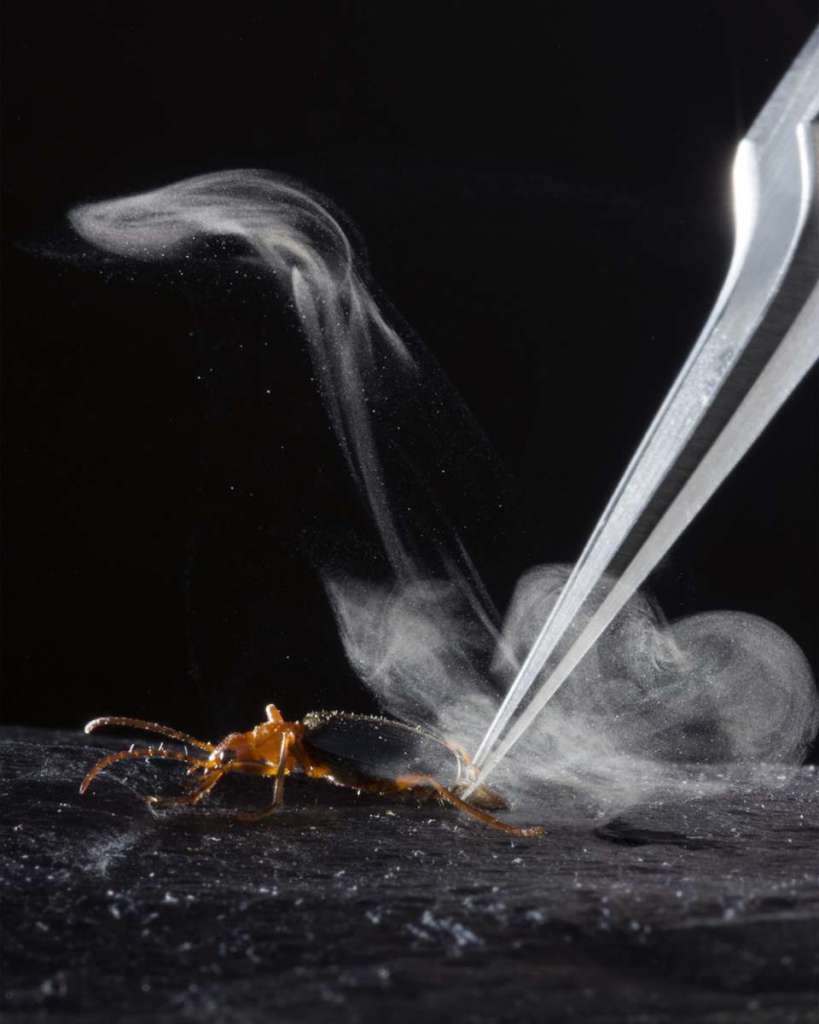

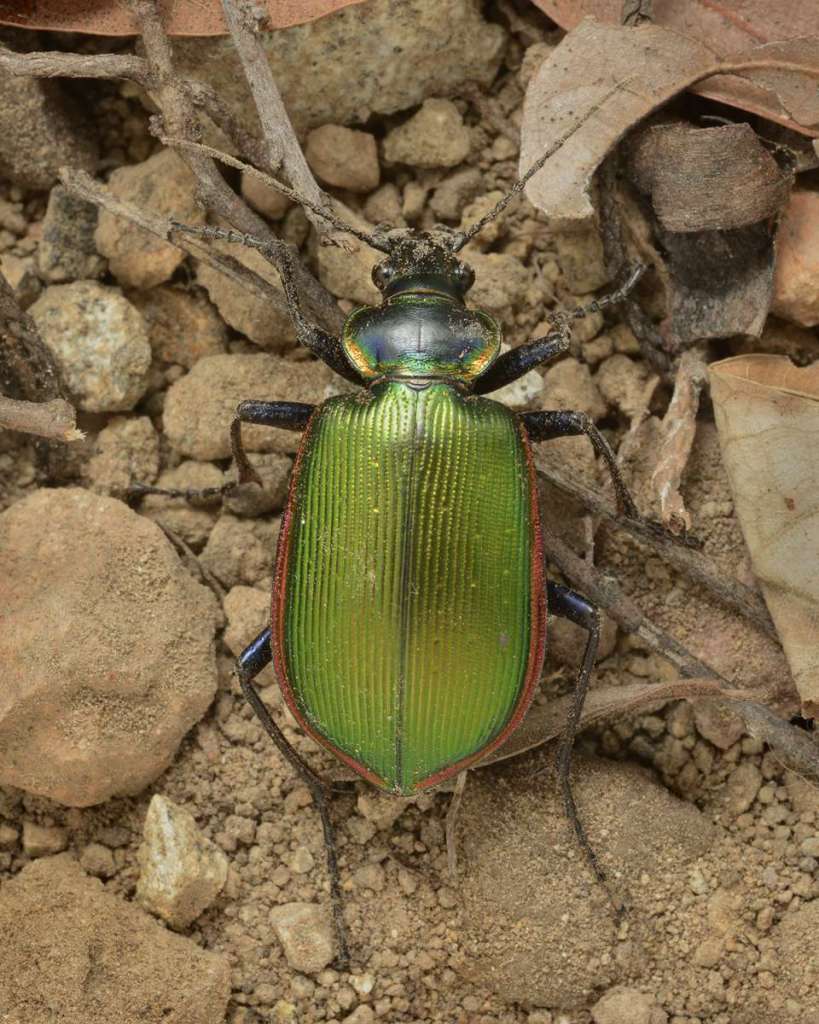
ABOUT THE ARTIST
“For more than 37 years I have been a professional photographer, exploring the biodiversity of the South West and Sonora Mexico. Influenced by such masters as Karl Blossfeldt and Edward Weston, my subject has always been the natural world and my tools have always been cameras; 4×5 view cameras, 35mm film cameras and the latest digital SLRs. Working in the field, alone, or with biologists and activists, collecting images, creating art.
The latest digital technology notwithstanding, I am always drawn back to the darkroom, the process performed by hand, and the traditional tools of my trade; film and archival gelatin silver prints.
A few years ago, adrift on the internet, in that tangential way that the web can get us lost, I discovered lumen prints. I began experimenting with the process and found it to be an amazing mix of alchemy and serendipity. An extremely experimental process that uses only sunlight and expired photographic paper. Many hours of solar exposure cause the paper’s gelatin silver emulsion to gradually change color. After fixing and toning the paper in my darkroom, I am left with a subtle negative image.
I have been experimenting with lumen print images of plants, feathers, and even insect parts, anything translucent enough to pass light. Combining silver gelatin paper with sunlight and the juices of herbaceous plants, creates subtle, pastel colors, in a paper designed to render only shades of gray. These unique, one of a kind images help me share the story of the natural world.”
ARTIST BIOGRAPHY
Charles “Chip” Hedgcock has combined his love of the outdoors with more than 30 years of experience photographing in medicine, the life sciences, and fine arts, to create a unique vision of the natural world.
Chip worked as a Medical Photographer at the University Medical Center at the University of Arizona in Tucson, AZ, and as a Senior Research Specialist, and chief photographer for the Division of Neurobiology at the University of Arizona. Currently, Chip is a photographer for the University of Arizona’s Department of Entomology.
For five years, starting in 2009, Chip was the lead photographer for the Madrean Archipelago Biodiversity Assessment, a program of the environmental organization The Sky Island Alliance.
Chip is a Black and White fine art photographer, continuing to practice the traditional tools of his trade, processing film and producing archival gelatin silver prints in his darkroom.
Chip holds a BA degree from Brooks Institute of Photography and is a Registered Biological Photographer, as well as a Fellow of the BioCommunications Association.
[/expand]
Arthropod-Inspired Artists
Alexandra Bowers
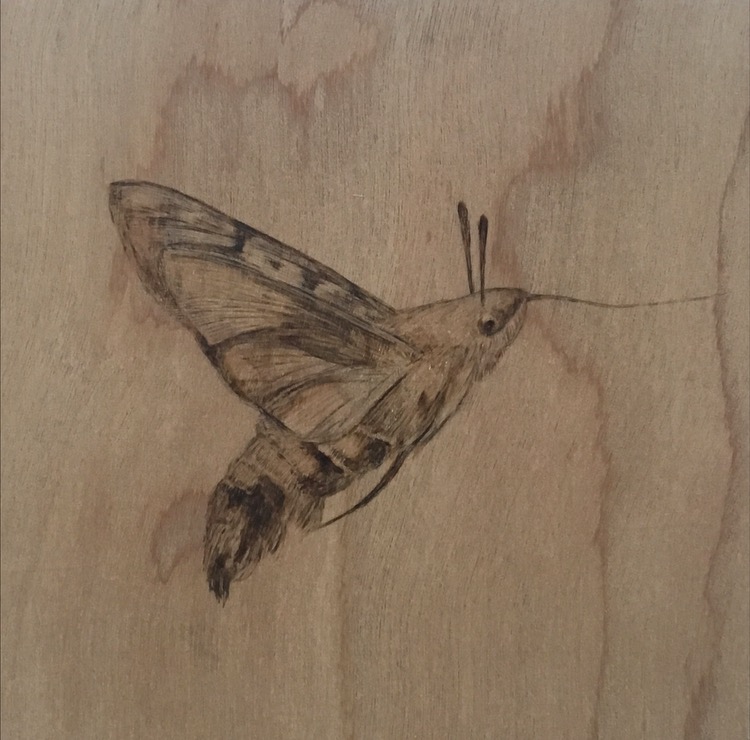
Hummingbird Moth
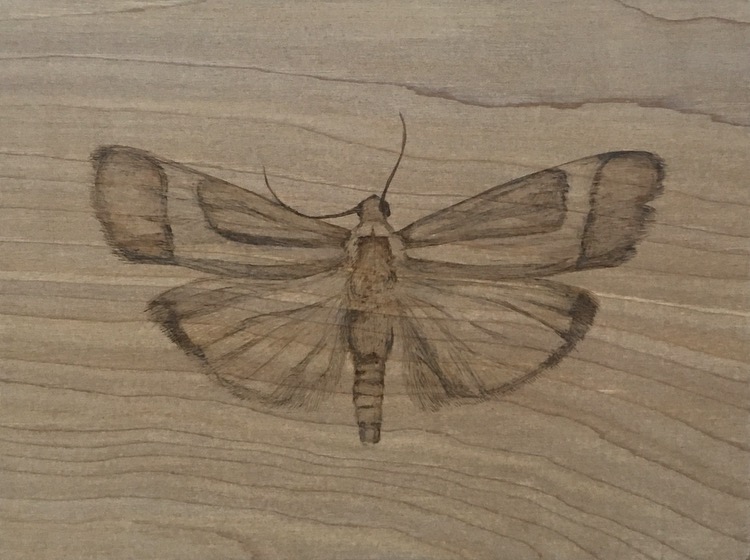
Thin Banded Lichen Moth
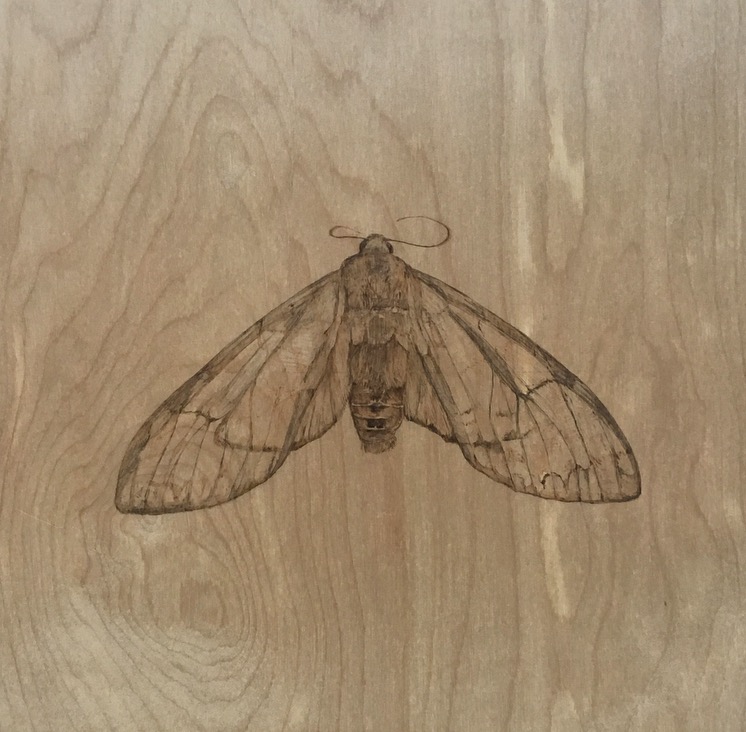
Grote’s Glassy Wing Moth
“What do you envision when you hear the word moth? Most people would think of pests, ugly brown winged creatures, or imagine their favorite sweater ruined by tiny holes. Preconceived notions aside, moths are extraordinary creatures that roam this entire planet. They pollinate flowers and assist in sustaining ecosystems by providing a source of nourishment to animals higher up on the food chain. However, what I feel to be most important, is that they are thought of as an ‘indicator species’ which help humans detect vital changes in our environment.
MORE
With there being so many in existence, it’s fascinating to me how little we as humans think about them. And why should we? Most of the time we experience them in their most unfortunate light- literally when flying into streetlights, or when they’ve made their way into our homes.
Though these creatures have a bad rep for being considered ‘gross’ and a nuisance, they’re quite remarkable. Just like their sister the butterfly, they progress through four phases of life. The final ‘adult’ phase is what I’m interested in emphasizing with these pieces because it is the most recognizable, while at the same time typically the shortest in their metamorphosis. And though it may be brief, it’s the most powerful in their life story because it’s the stage that allows them to continue their legacy on this planet.”
to learn more about ALEXANDRA BOWERS go to: https://alexandrabowersart.com/home.html
Brooke Molla

House Collection (blue)

House Collection (red)
“House Collection is a series of prints that explores the animals and insects of an unseen natural world. Many creatures of the desert only come out at night especially in the summer. We don’t see them but we can hear the screaming of a cat being caught by a coyote or find remnants of moths and insects under the porch light to attest to the nocturnal drama.”
to learn more about BROOKE MOLLA go to: https://www.brookemolla.com/l
Carolee Asia
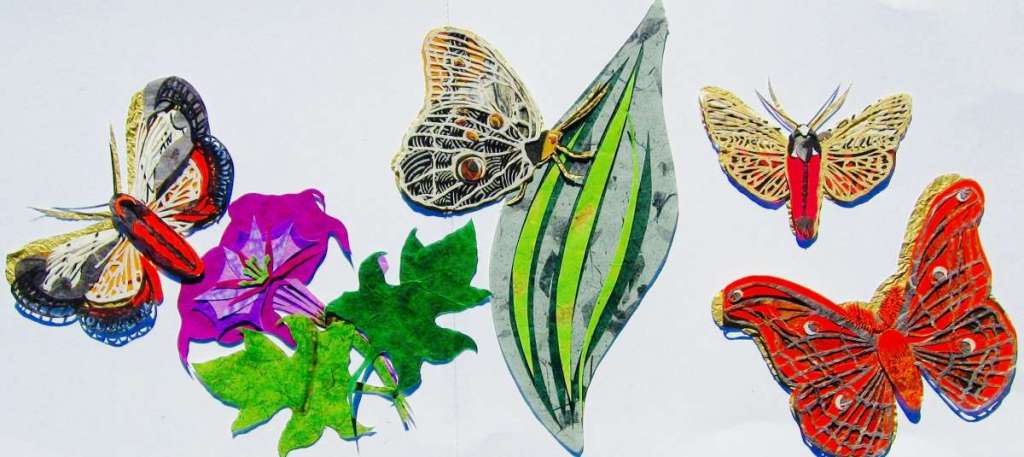
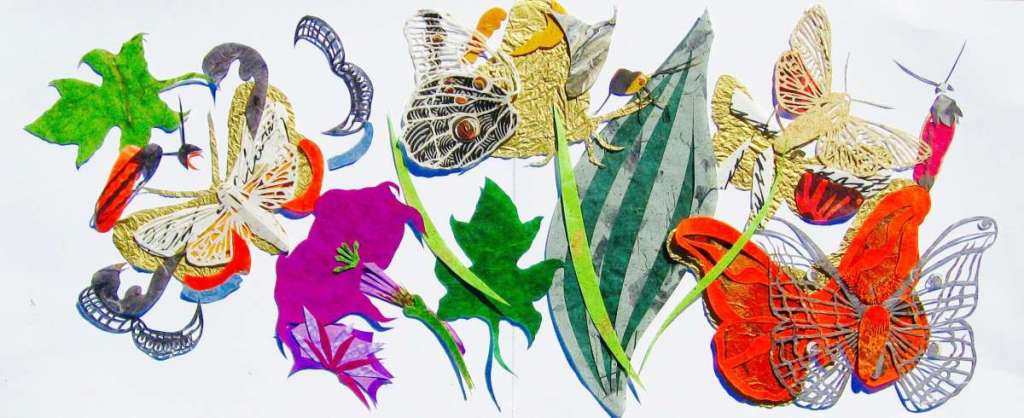
Sonoran Desert Lepidoptera Bowl design elements
MORE
“The outside of the bowl represents the nocturnal desert with designs of two Tiger Moths from the Arctiidae Family, one pink and one mostly orange and white with blue details. The third nocturnal moth is a red-veined Sonoran Silk Moth from the Saturniidae Family. They hover around a night blooming Oak-Leaf Datura, Solanaceae Family.
Inside the bowl representing the daytime desert, are two Cloudless Sulphur Butterflies from the Pieridae Family and a Western Tailed Blue Butterfly of the Lycaenidae Family. They join an Argemone Mexicana desert thistle from the Asteraceae Family.
On the base of each bowl will be a Praying Mantis, Mantis Religiosa, from the insect order, Mantodea, and the Family Mantidae.”
[expand title=”MORE ARTHROPOD ARTISTS” rel=”fiction”]
Amanda Rohrbach
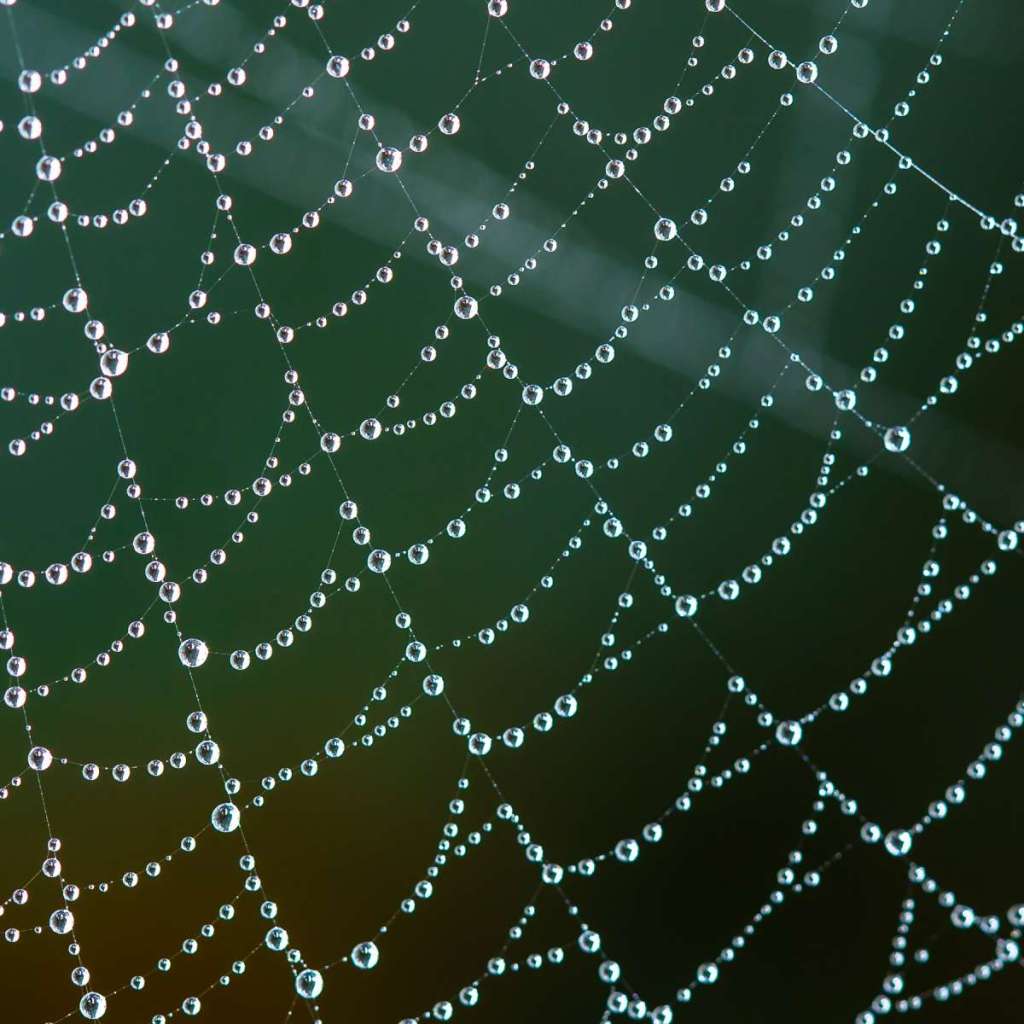
The Web
“I am constantly drawn to patterns in nature, both large and small, and frequently isolate part of a subject to study the forms in abstraction. The Web is part of a beautiful spider web in our yard that lasted for over a week and caught the morning dew in spectacular fashion, making tiny worlds within worlds.”
Ric Nielsen
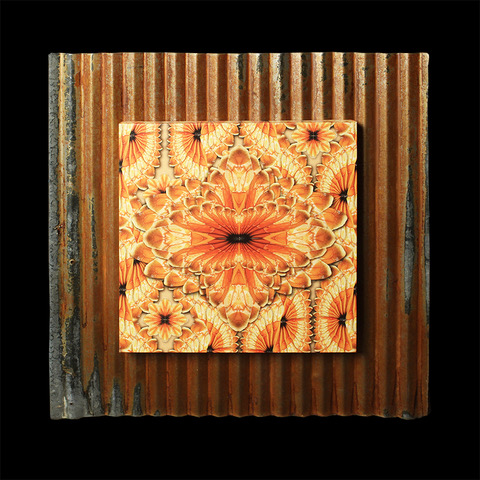
Tarantula Hawk Splendor
The color of the Sonoran Desert comes from many things: plants, earth, animals, insects and more. The Tarantula Hawk Wasp brings its own brand of color into view as both a warning and a show of beauty. With a contrasting black body and magnificent orange colored wings, the Tarantula Hawk was one of the early treasures I
More
found while creating my art. The patterns created from the orange and yellow wings are amazing. The frame is a corrugated steel panel salvaged from a section of an old building in the Tanque Verde area of Tucson.
to learn more about RIC NIELSEN go to: https://www.ricnielsen.com/
Matt Mays
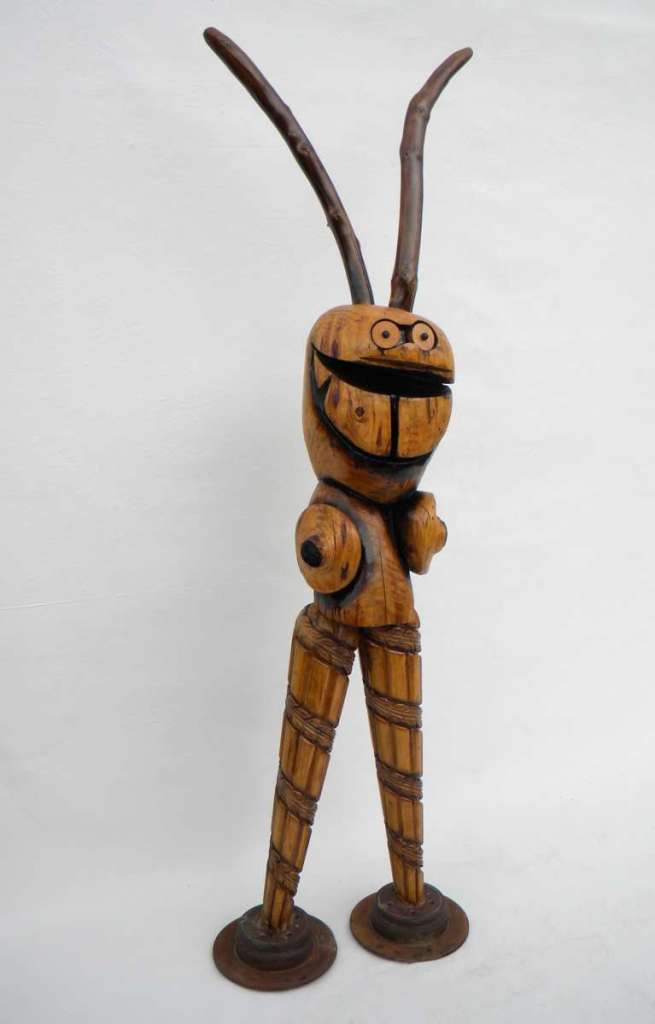
Buzz Worn Thin
“The carving series I’ve been working on for many years has stretched my attention span to new lengths because of its slow and tedious process. The found, larger-than-life log sculptures remind me of
More
dysfunctional antique wooden toys reminiscent of ancient idols –- absurd in a modern context.
Clothing wears out; metal and wood tarnish and crack. I use recycled materials found in back alleys and thrift stores in my sculptures. Combining elements from different time periods conjures emotional memories and an intuitive dialogue about producing material indulgences—a phenomenon that limits our existence through its distractions and irreversible damage to the natural world.”
to learn more about MATT MAYS go to: https://mattmaysart.com/
Brian Hooker
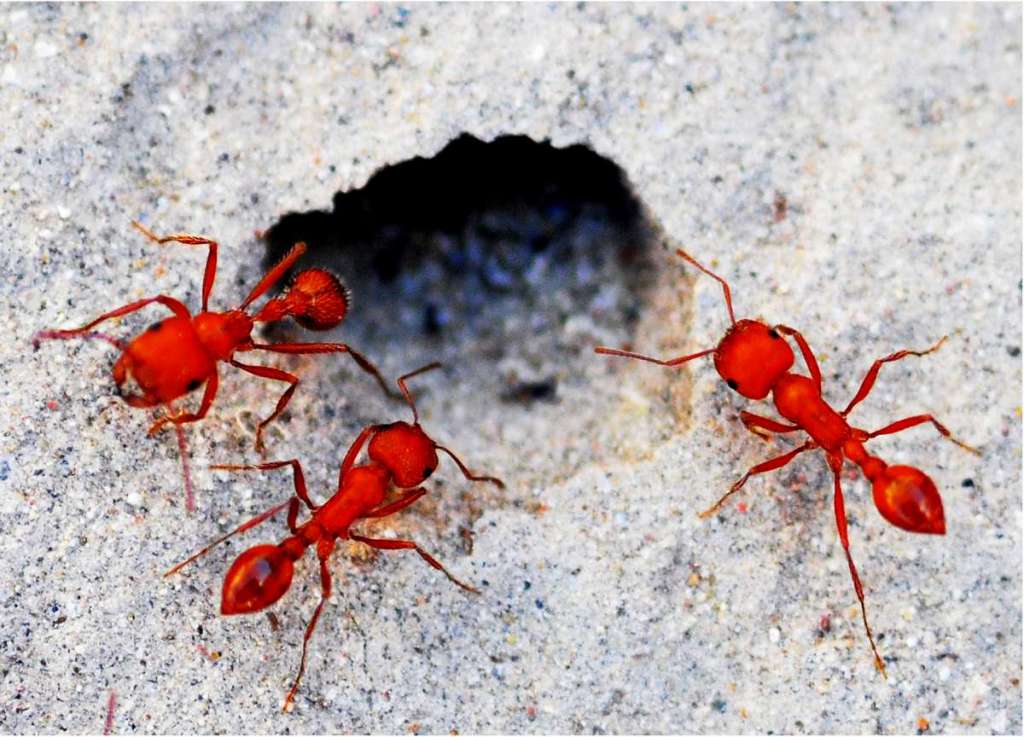
Portal
“The portal serves as a transit channel between the surface world and the hidden world. While the surface world provides food and light, the hidden world provides safety and nurturing. Different planes of existence are necessary to survive, and finding a portal allows one to pass between these two essential worlds.
More
to learn more about BRIAN HOOKER go to: https://brianhooker.zenfolio.com/
Manuel M. Fontes
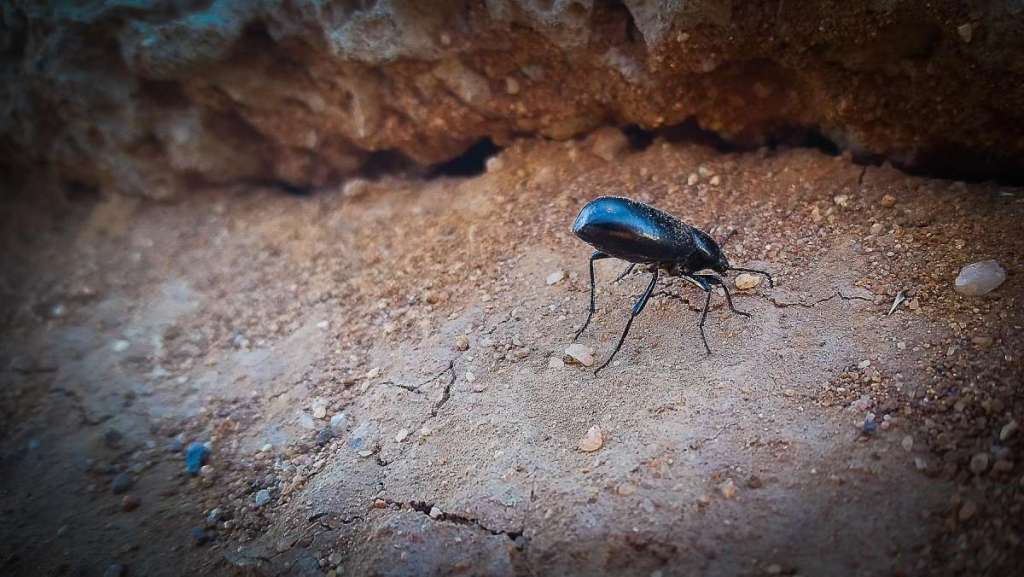
The Beetle and the Moon
“In 2016 we had the opportunity to witness a celestial event known as the ‘Supermoon.’ This event was the closest the moon has been to Earth since 1948 and the moon will not get that close again in its orbit until November 25, 2034. The Supermoon was a spectacular event drawing the attention of many as they gazed at the evening sky. Even this humble Pinacate Beetle or as it is better known, the ‘Stink Beetle’ of the Sonoran Desert took a moment to
More
marvel at the Supermoon as well. Notice the beetle’s head tilted towards the landscape as it admires the moon which reflects upon its tiny black shell.”
Mark Thaler
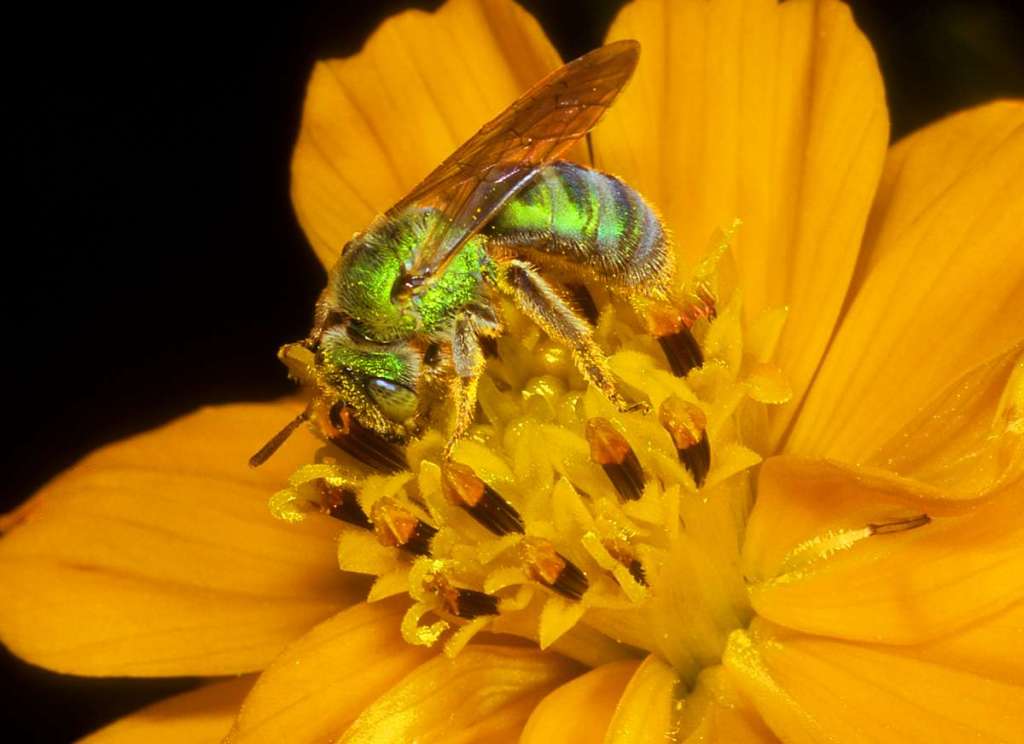
Green Metallic
The path to successful pollination are numerous and quite varied which opens up a rather amazing window of possibilities. Bees play a major role in transferring pollen and are quite fascinating to witness during energetic visits to an impressive variety of flowering plants. This photograph was taken as a sweat bee (Family: Halictidae ) found nectar and
More
nourishment grazing the florets of a cosmos flower (Cosmos sulphureus ). Green metallic bees can shine with golden pollen grains gathered along the way.
Christopher Allison
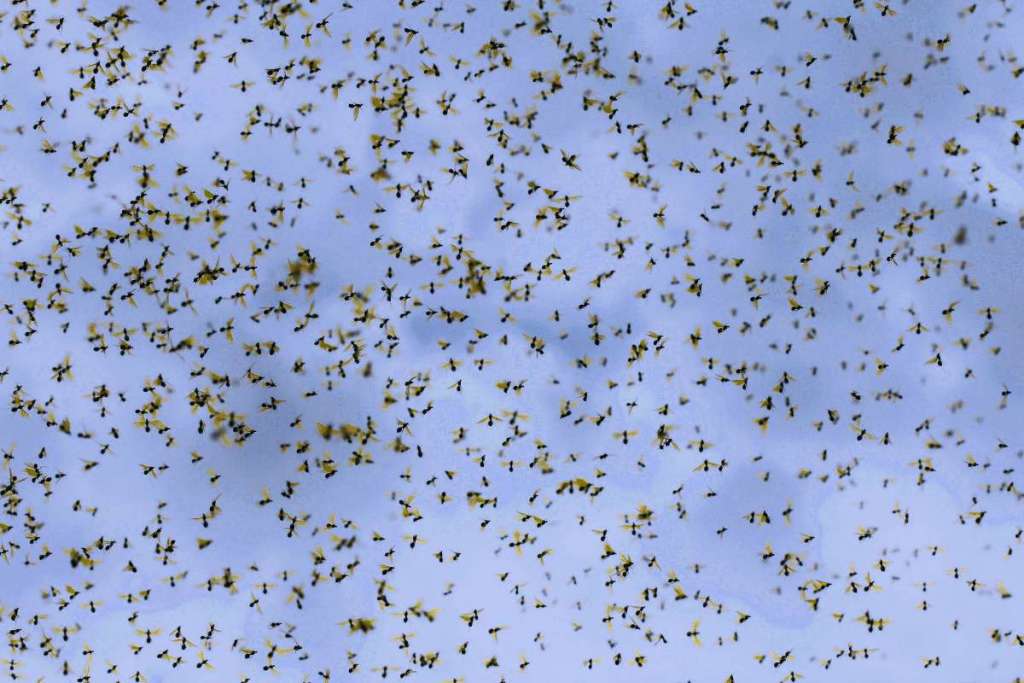
Leaf Cutter Ant Nuptial Flight
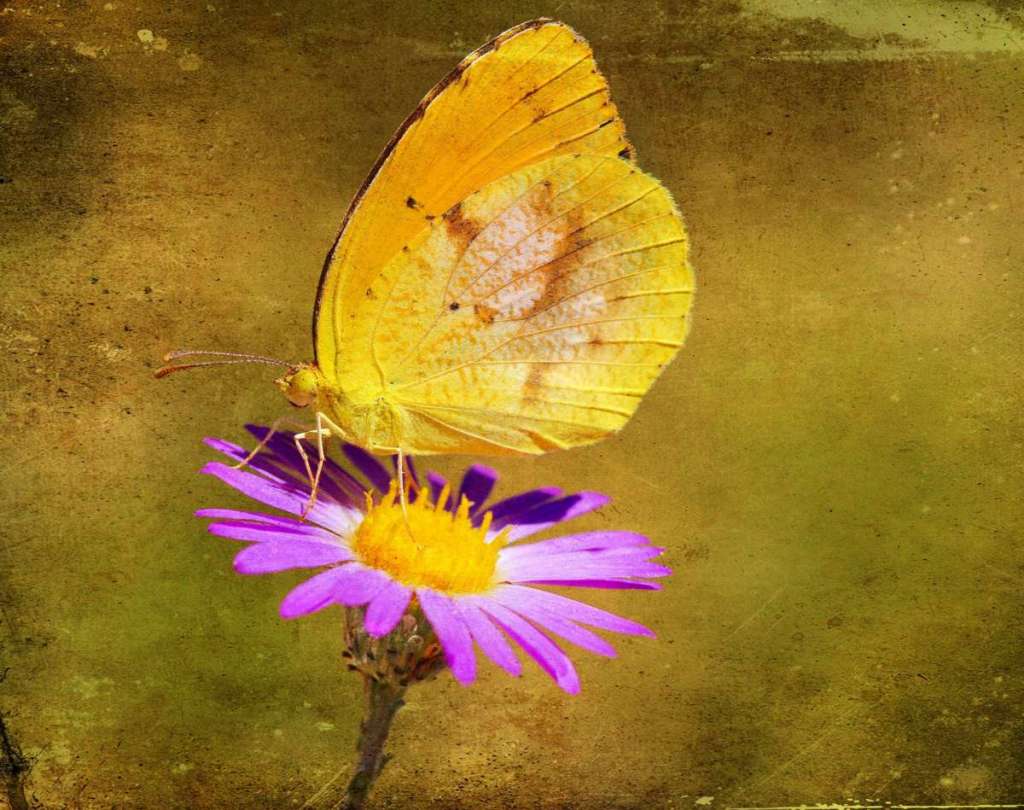
Sleepy Orange Butterfly
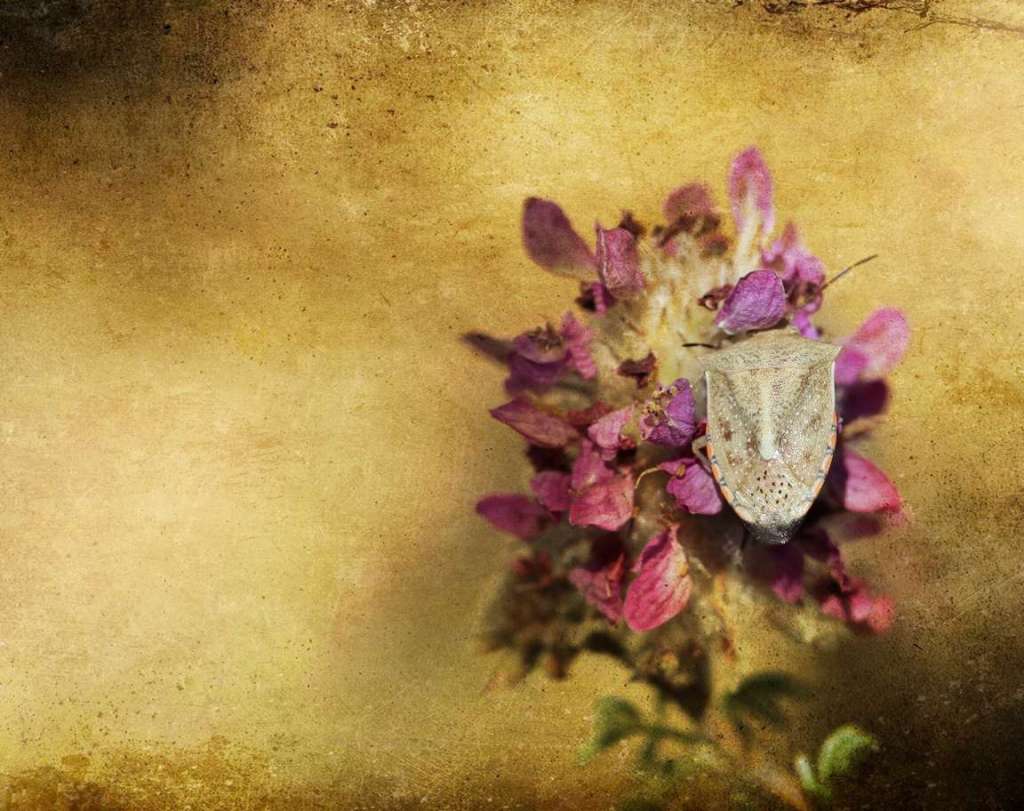
The Shielded Pollinator
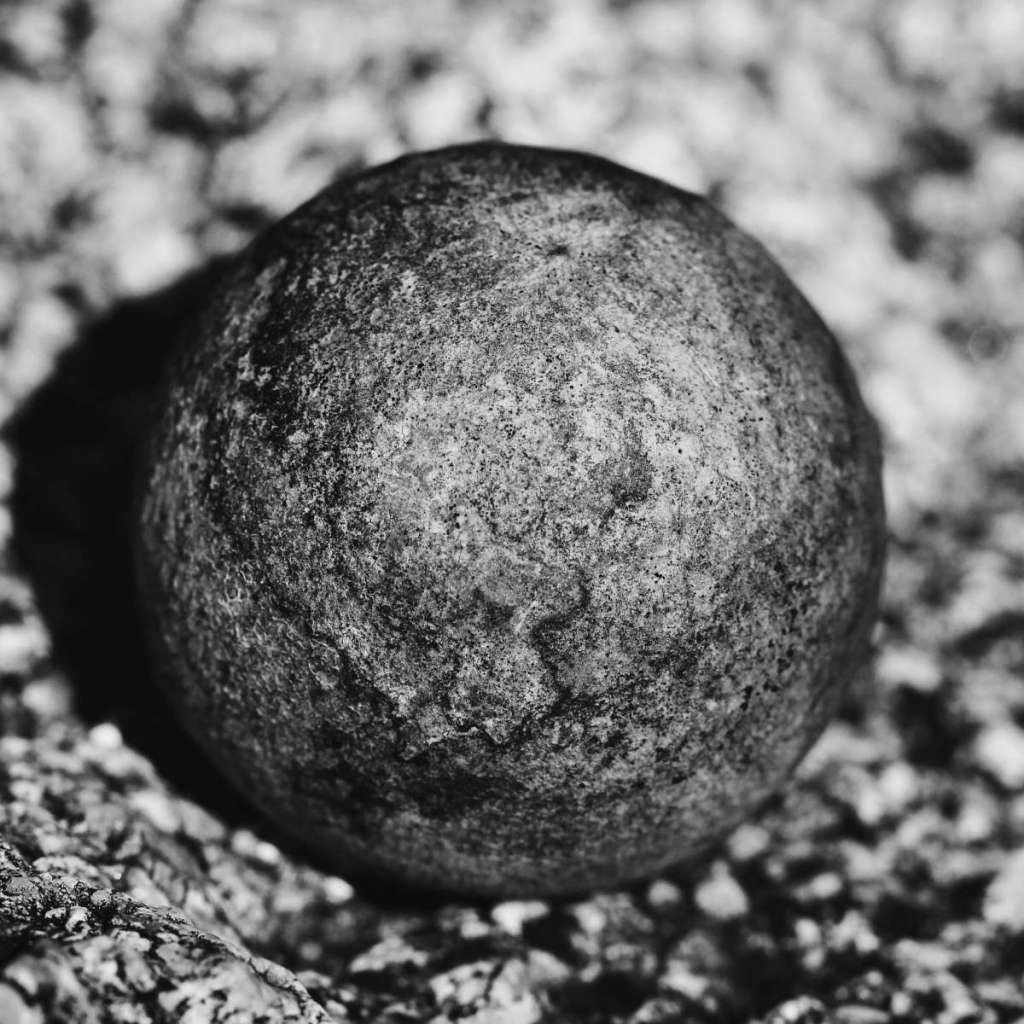
Mexican Blue Oak Wasp Gall
SEEKING SHELTER:
“The relationships between flowers and their pollinators are fascinating and complex. Each of these photographs demonstrate examples where insects were using flowers for shelter. The bees and wasps returned to the same flowers nightly to roost. I photographed them at sunrise over several days. The Sleepy Orange Butterfly was clinging to an aster during warm gusts of wind. It remained there for some time calmly resting. These three photographs were taken near my home. I am fortunate to live in Tucson, a place where nature’s persistence and perseverance make it a constant companion. From abundant birdlife to a seemingly endless variety of insects I am constantly fascinated and inspired by my surroundings.”
More
1. Bachelor Longhorned Bees roosting on Desert Aster
“These two Bachelor Longhorned Bees were cradled in the slightly open petals of a Desert Aster early one morning. Some of the flowers that I observed had several bees clustered together each night. This social behavior is most likely done to help warn each other of the approach of predators.”
2. Sleepy Orange Butterfly (Abaeis nicippe) on Desert Aster
“This Sleepy Orange Butterfly stopped to rest on a Desert Aster during a windy day. I observed it for some time and noticed that it did not feed, but instead appeared to use the swaying flower for shelter.”
3. Thread Waisted Wasps (Ammophila procera) on Desert Aster
“During the early summer, groups of Thread Waisted Wasps would roost on several Desert Aster plants in my yard each night. They would cling to the plants using their mandibles. Their abdomens were often flexed outward. The wasps would remain still until warmed by the sun each morning and would return about half an hour before sunset each night.”
SYMBIOTIC RELATIONSHIPS
4. Leaf Cutter Ant Nuptial Flight, Tucson, Arizona
“The nuptial flight of the leaf cutter ant carries with it an ancient form of symbiosis. Leaf cutter ants collect leaves to create underground fungi gardens. Unable to digest the leaves, the ants process them into food for the fungus. The fungus then feeds the entire colony. After a monsoon rain, winged male and female ants emerge and converge in mating swarms. Each queen carries a small amount of fungus with her to start a new colony.”
5. Mexican Blue Oak Wasp Gall, Molino Canyon, Catalina Mountains
“The unusual growths seen on the leaves of Mexican Blue Oak trees are often the result of gall wasps. These wasps lay their eggs in the leaves of the trees which respond by forming a cyst like structure around the egg. When the larvae hatches it feeds on the gall.”
6. The Shielded Pollinator, Soldier Canyon, Catalina Mountains
“The role of pollinator is not just limited to bees and butterflies. There is an incredible array of insects that are attracted to flowers. This shield bug rests among a cluster of flowers. Whether for shelter or food, this relationship demonstrates the deep connections found between plants and insects in the Sonoran Desert.”
7. Pollinators and Pests Welcome, Ventana Canyon, Catalina Mountains
“A Green Lynx Spider positions itself on the flower of a prickly pear waiting for prey to arrive. While they do prey on beneficial pollinators, these spiders also eat pest insects and their larvae that could damage the cactus.”

Thread Waisted Wasps

Bachelor Longhorned Bees Roosting on Desert Aster

Pollinators and Pests Welcome
Robert Renfrow
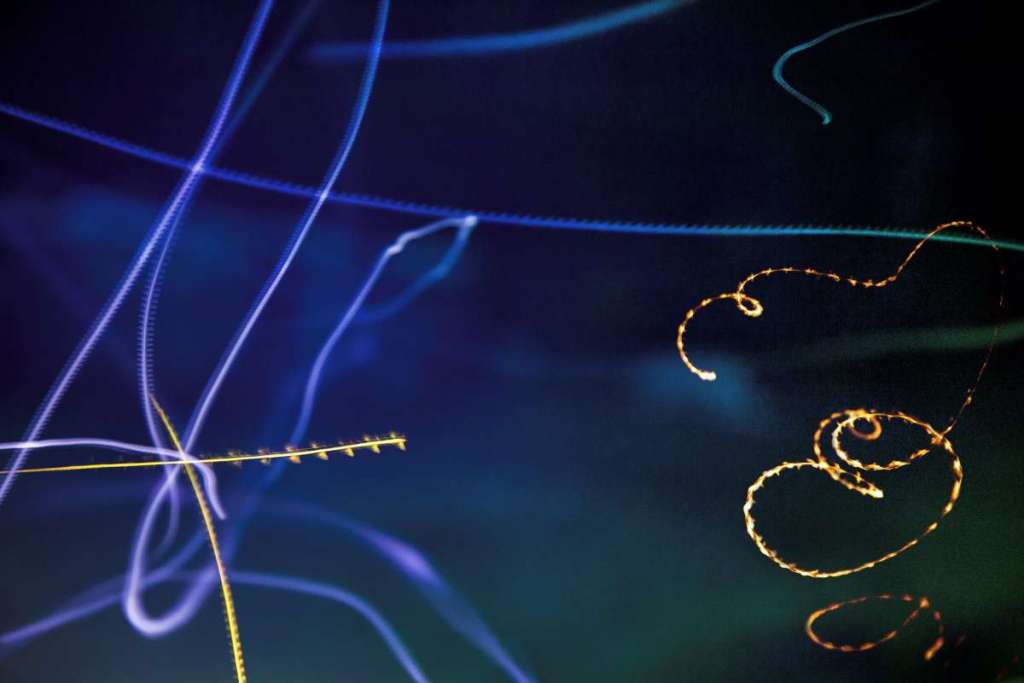
Moths 1
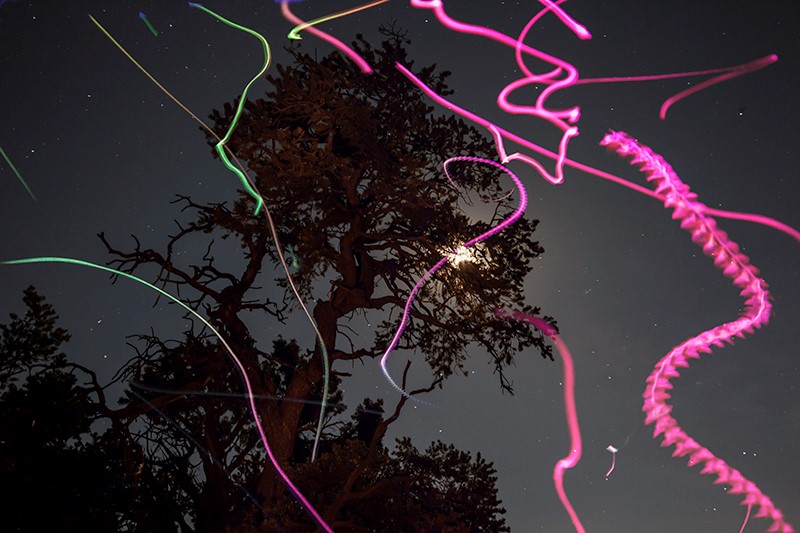
Moths 4
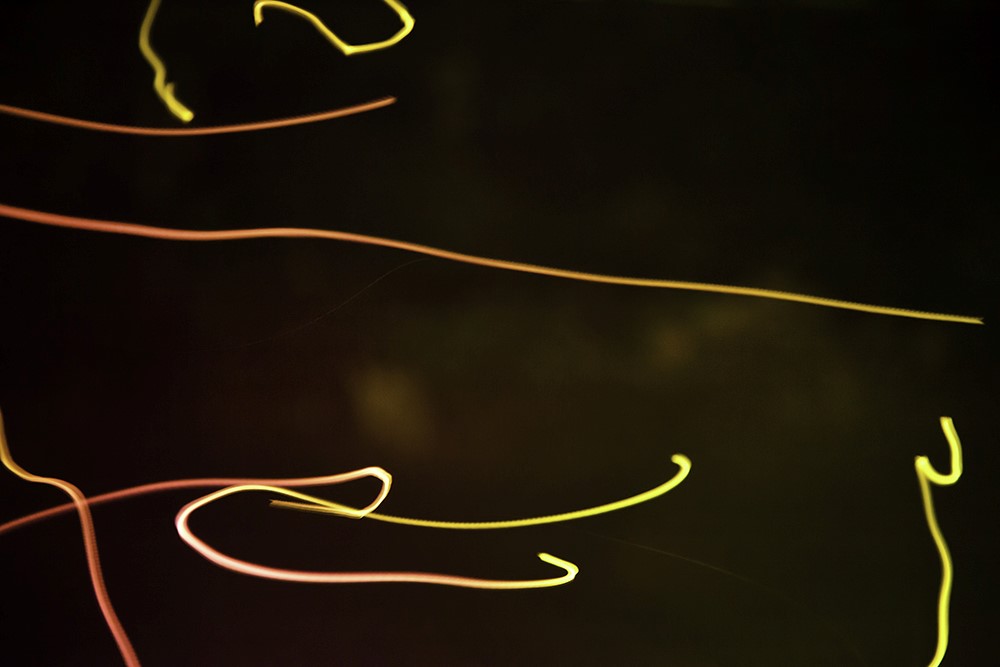
Moths 6 Yellow
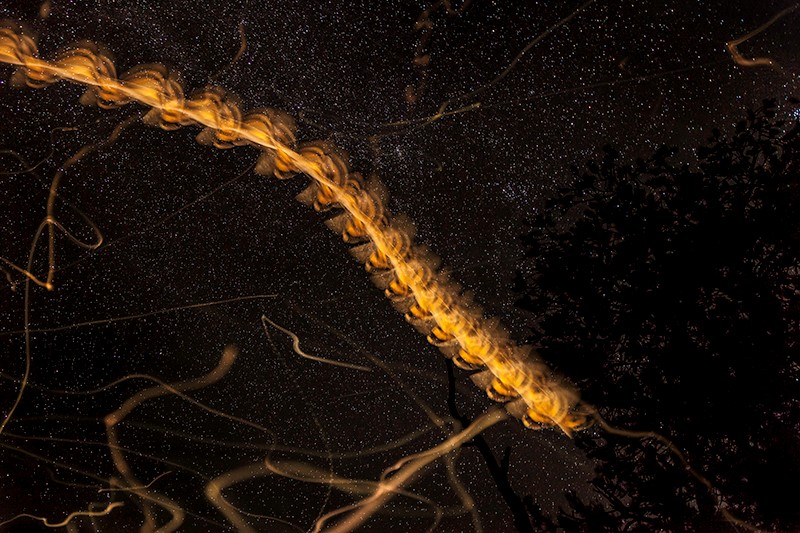
Moths 7
Shining light into the darkness:
“Moths on Metal’ is a series of photographs depicting moths flying at night. By using a slow shutter speed and other photographic techniques I am able to create images reminiscent of abstract expressionist paintings. One of the many things I like about photography is the camera’s ability to ‘see’ things our eyes can’t – especially in regards to time. As the moths fly, they create beautiful patterns and forms we are usually unable to see. Sometimes these unseen patterns echo other patterns found in nature such as plants, skeletal structures and aquatic forms.”
to learn more about ROBERT RENFROW go to: http://www.robertrenfrow.com/
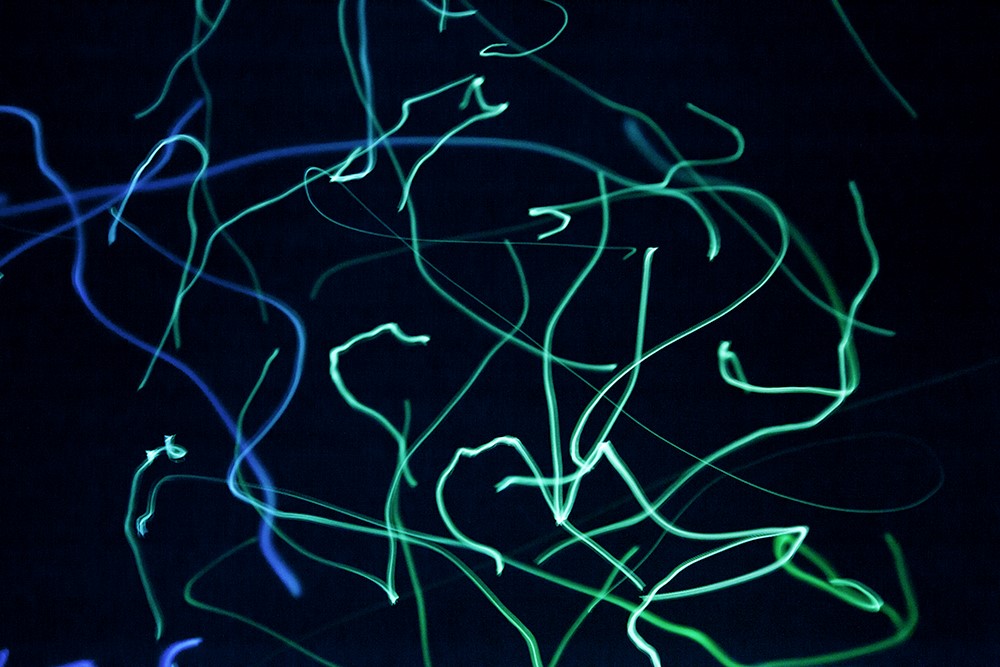
Moths 7 Blue
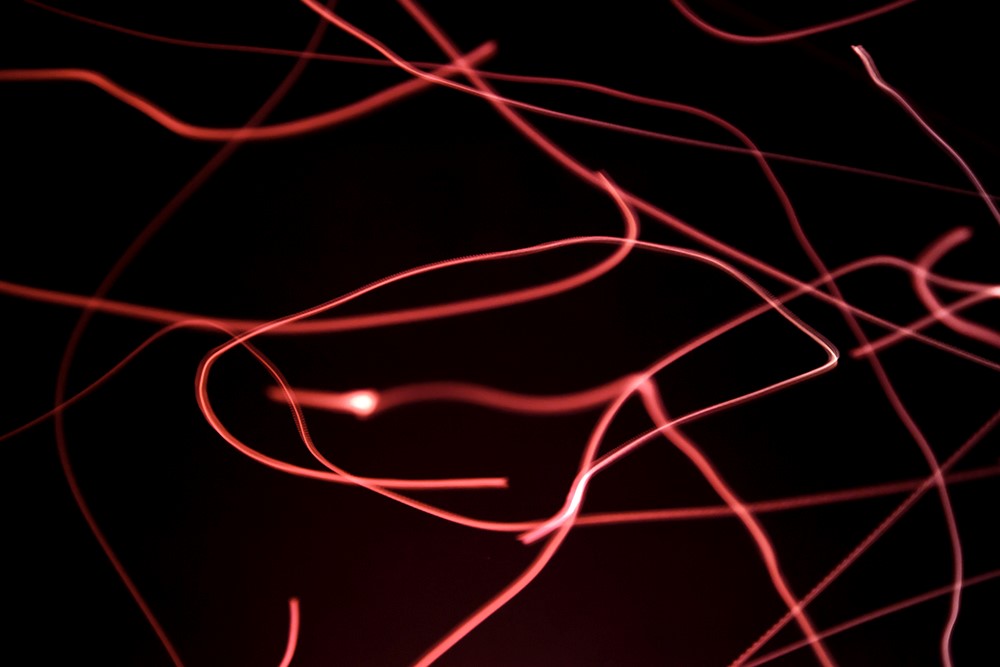
Moths 8 Red
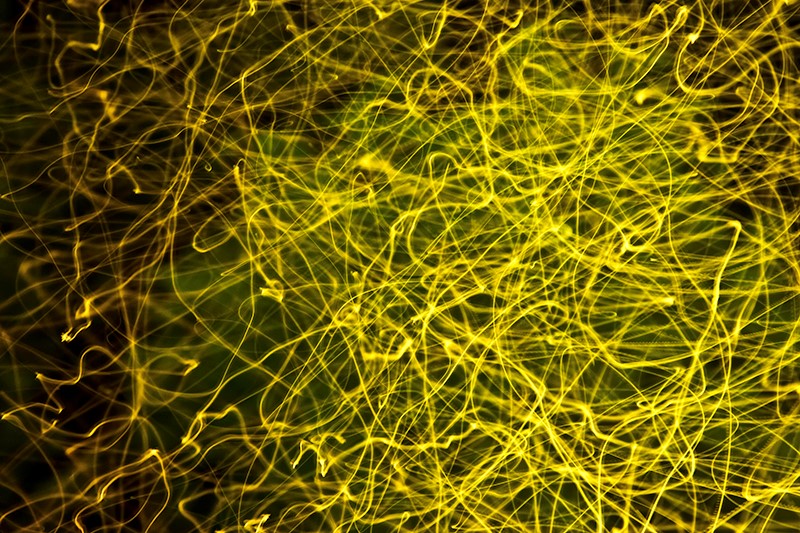
Moths 9
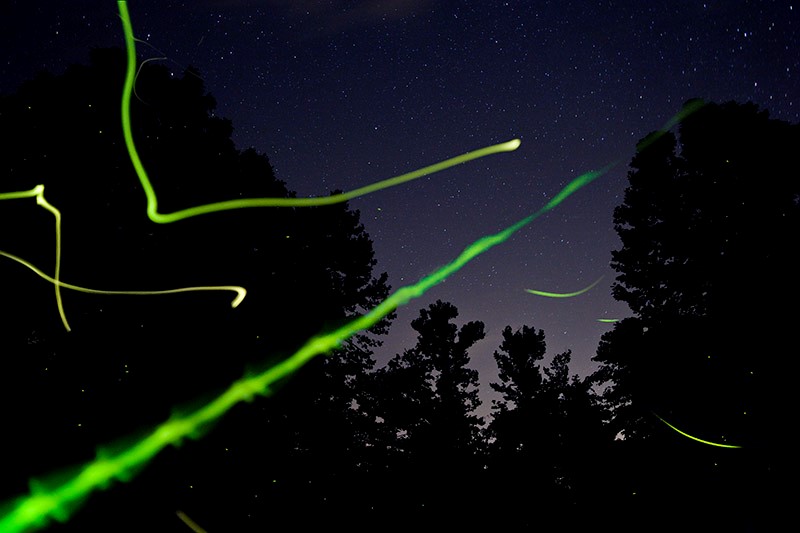
Moths 10
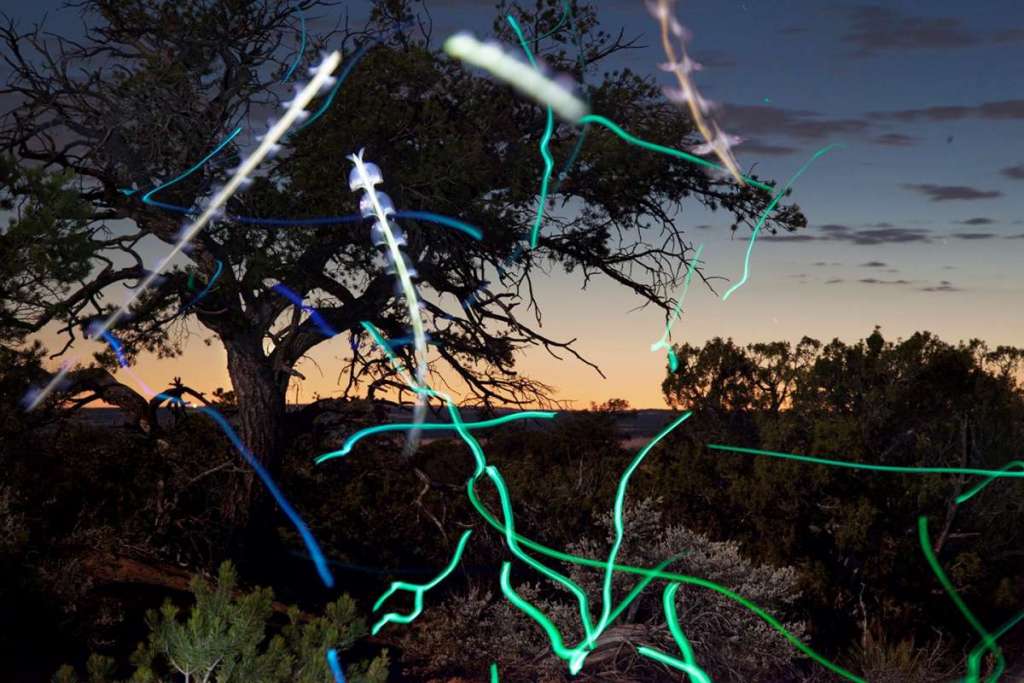
Moths Over Navajo
[/expand]
Arthropod Art
Jennifer Angus – In The Midnight Garden
Agnieszka Kurant – The Woman Making Art with Termites
Ants
Japanese artist Yukinori Yanagi – World Ant Farm and Wandering Position
Yukinori Yanagi, Artist
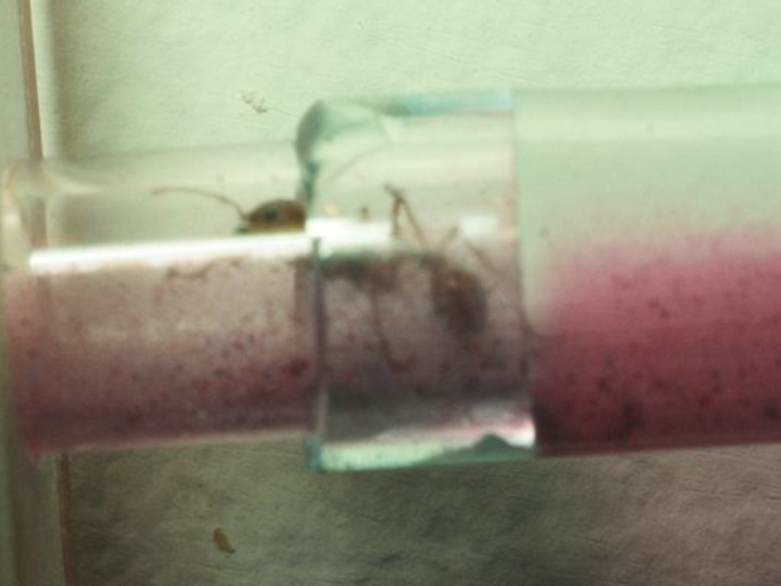
Pacific
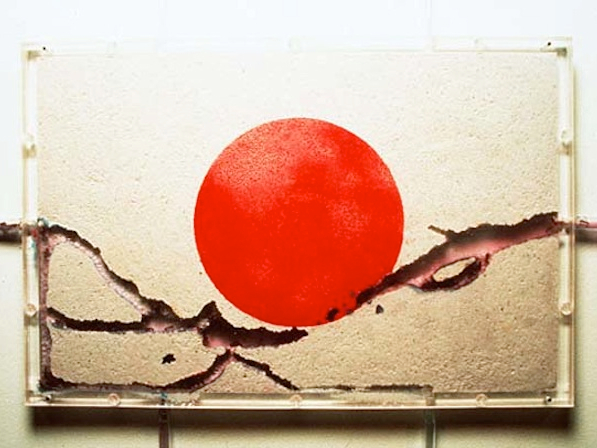
The United Nations of Ant Farms
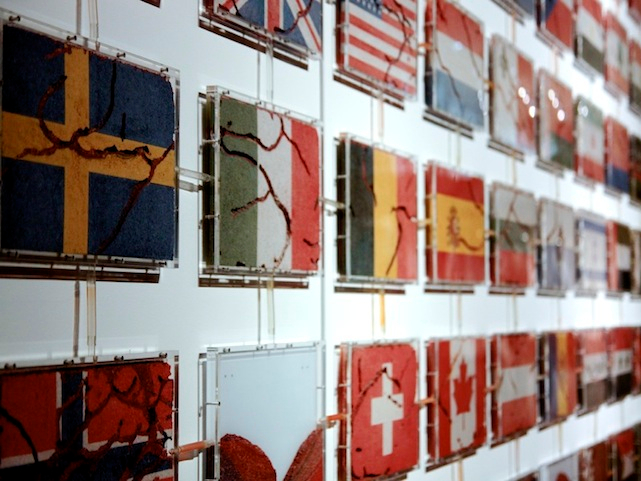
Spiders
The Art of the Spider’s Web

Tomás Saraceno
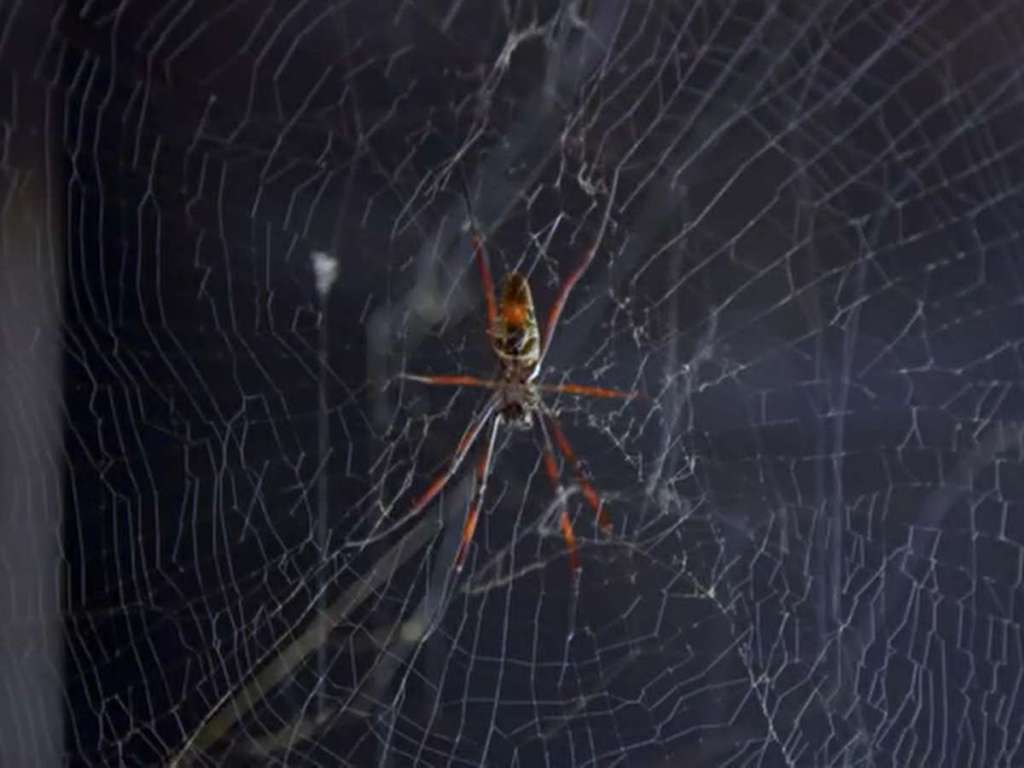
Hybrid Webs
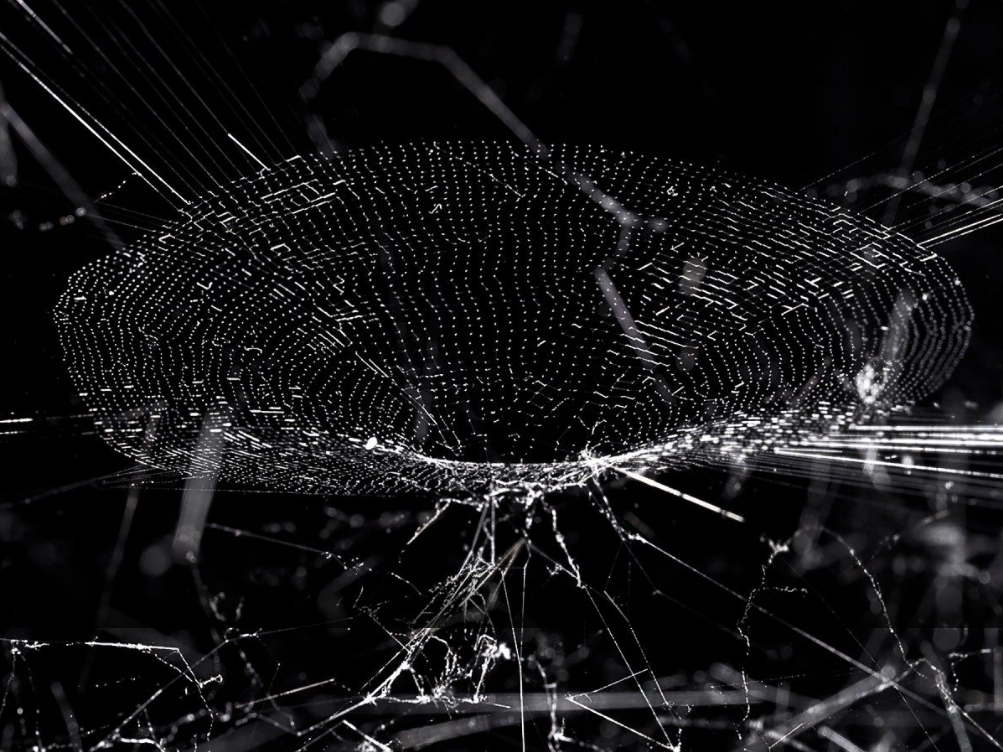
Spiders and Musical Webs

Spiderwebs Transformed
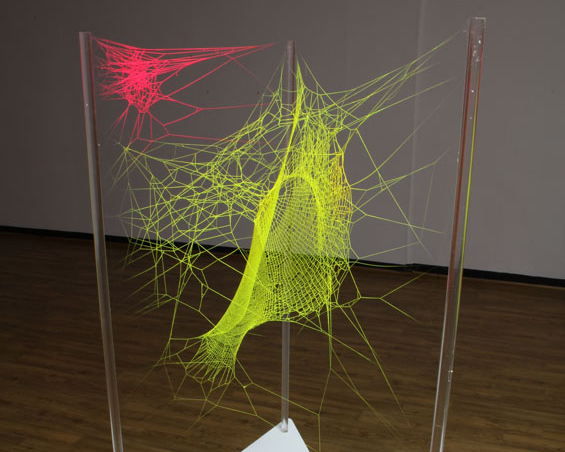
This Farm Harvests Spider Webs for Art
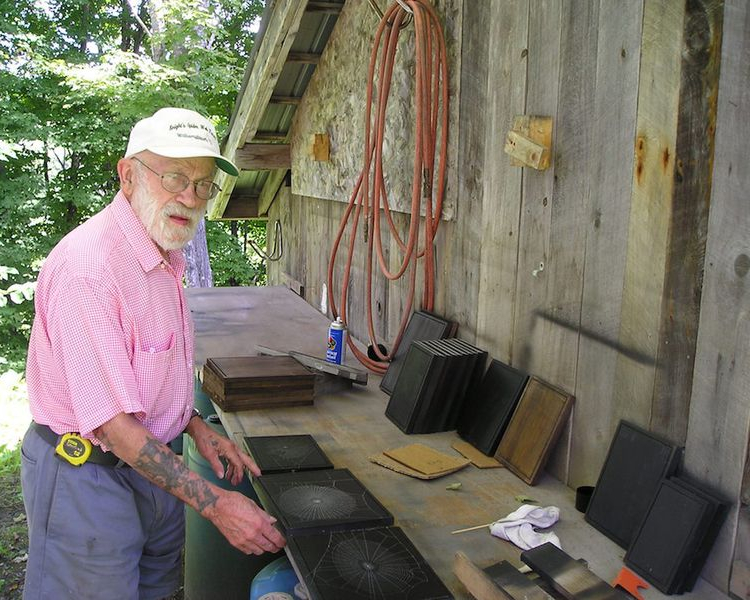
SPIDER WEB ART in Vermont
Additional Inspired Artwork
Beauty Through the Microscope
Yayoi Kusama Infinity Mirror Room
The Secret Designs of Moths – Podcast

Day 5 – Weekend Inspiration
How To Turn Stuff From Your Yard Into Stunning Insect Sculptures
Canadian Artist Raku Inoue
Build Your Own Spider In A Web
SUPPLIES:
- paper plate
- colorful yarn
- a piece of colored construction paper
- 2 pompoms – one large one small
- a pair of scissors
- glue
- optional, a hole-punch and a stapler
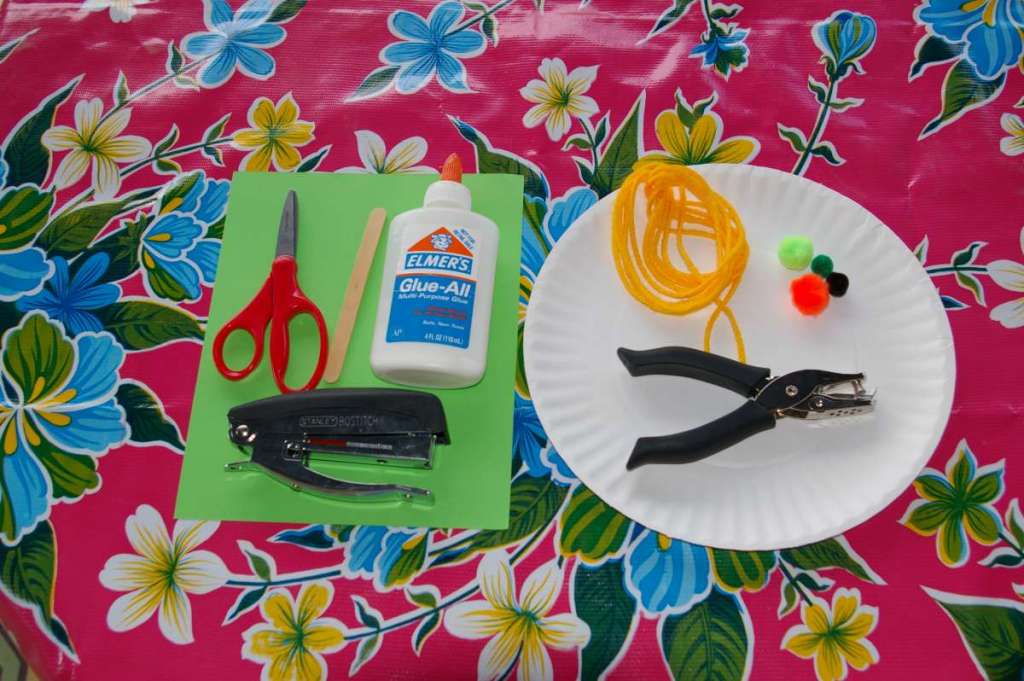
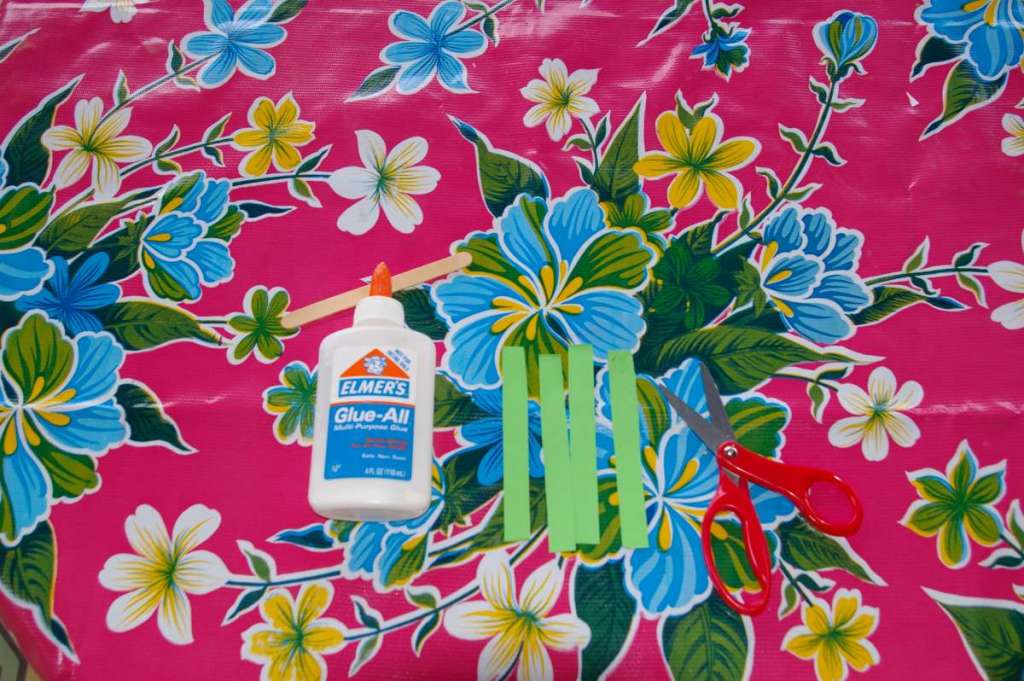
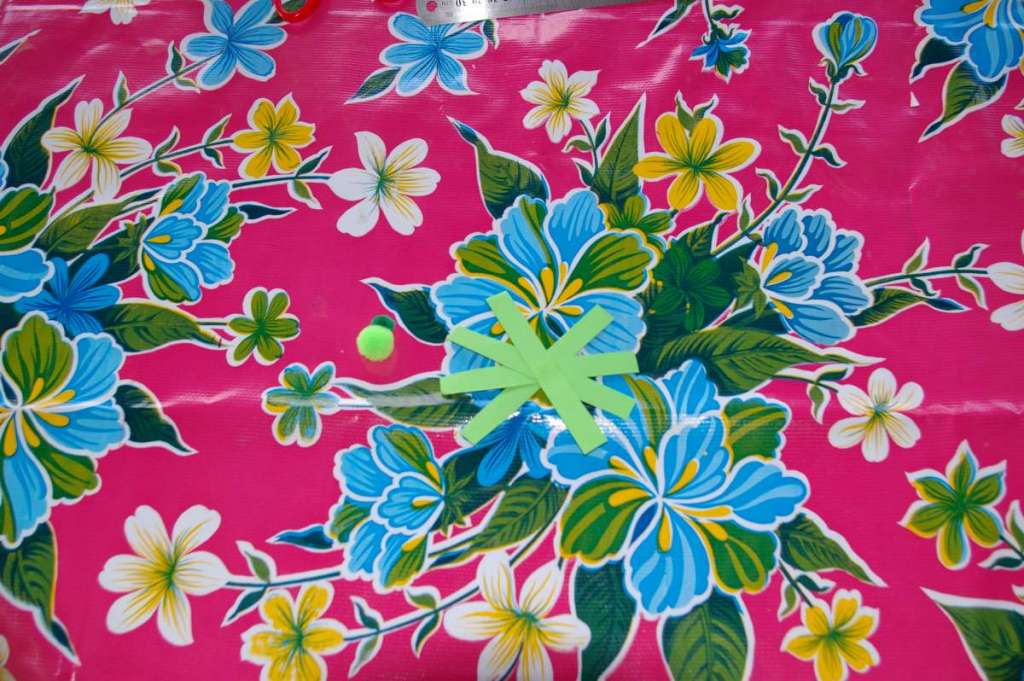
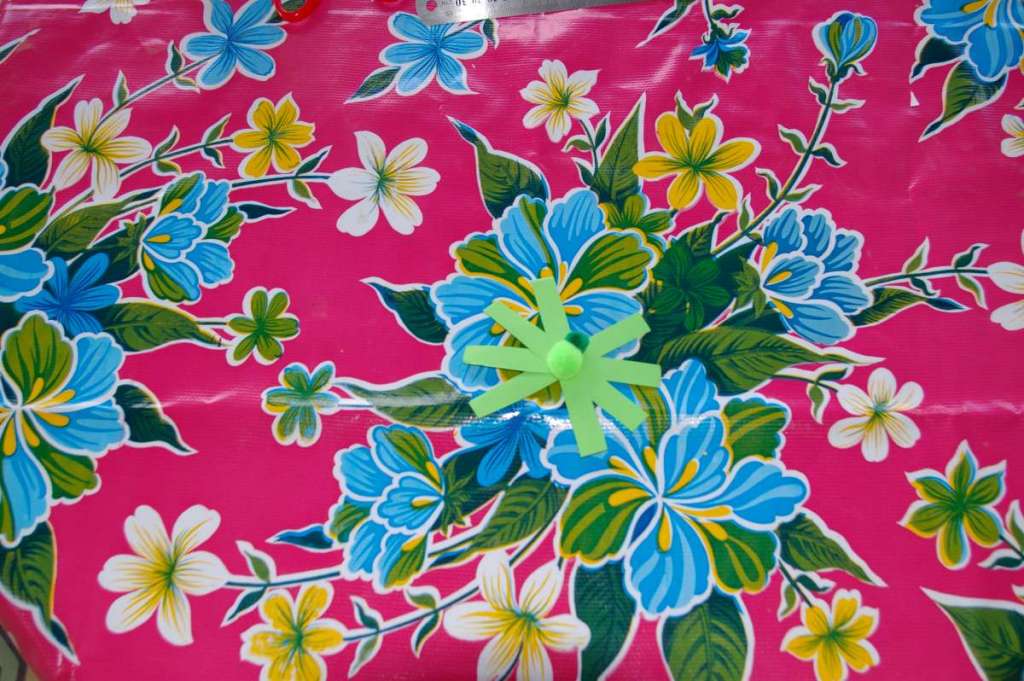
INSTRUCTIONS:
- Cut four strips of construction paper four inches long by ½ inch wide. Staple or glue these together to make eight legs.
- Glue a small puffball onto a large puffball to make the spider’s body.
- Glue the spider’s body onto the legs. Let the glue set while you make the web.
- Cut center out of a paper plate to create a paper ring. Color the ring, if desired. Add stars, or spiderlings, or whatever you want. Punch about 7 holes in the rim, spacing evenly.
- Thread the yarn across the ring and through all 7 holes to make a web, and tie securely. Tie a loop at the top to make a hanger.
- Glue your spider onto the web by folding one foot over the yarn and gluing.
- Hang your web in a window or from the ceiling and wait for a real spider to find it!
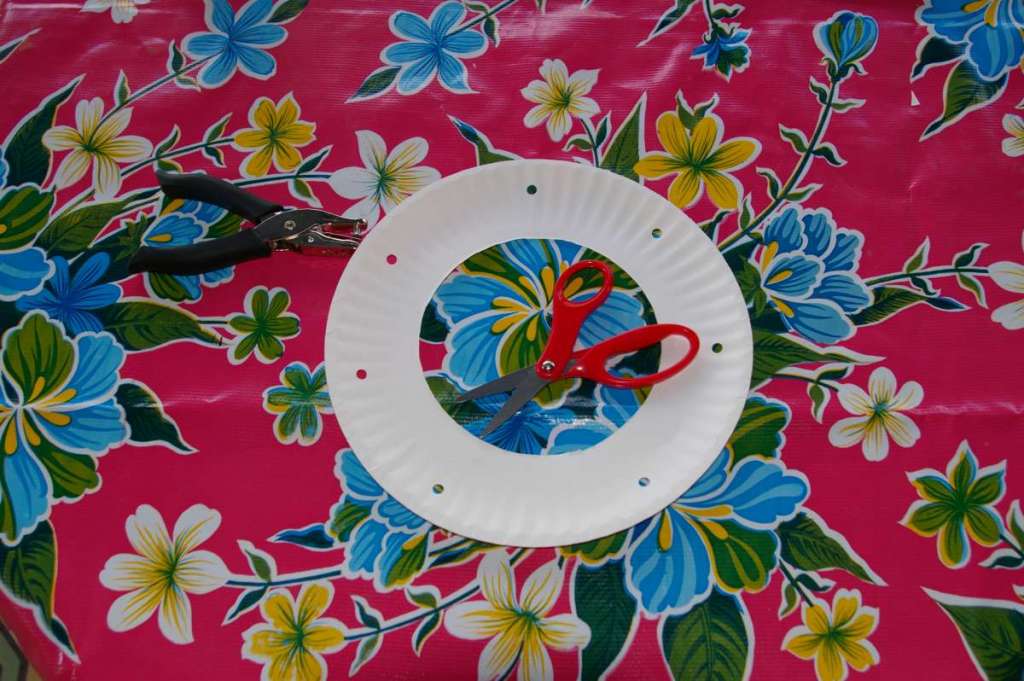
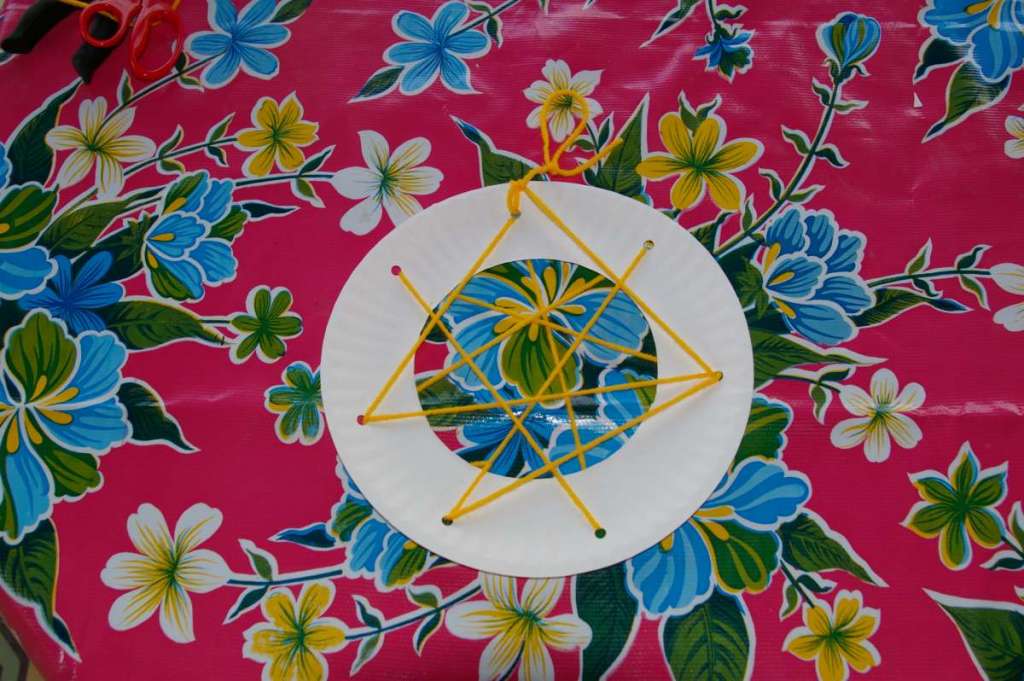
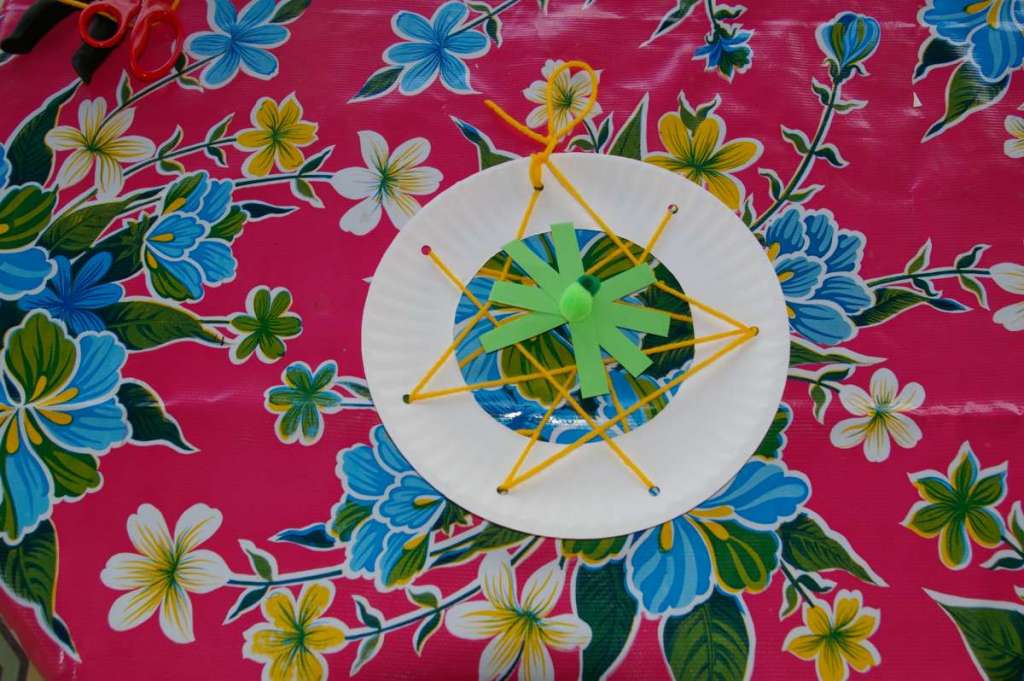
Next Week’s Inspiration
